The
Joseph Donaldson, Jr.
Memorial Online Museum
(est. 2004)
Dedicated to the Memory of Joseph Donaldson, Jr. (Jan. 30, 1914 - Jan. 1, 1997)
2014 - the Centennial of Joe's birth and the tenth anniversary of the Joseph Donaldson, Jr. Memorial Online Museum
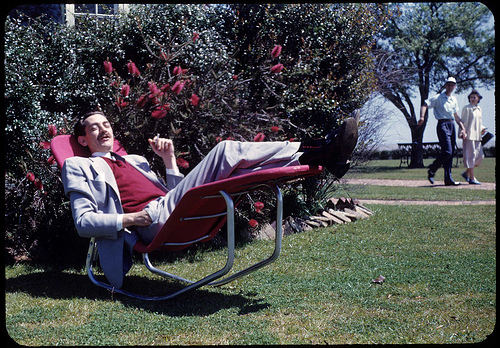
Joe Donaldson relaxing at the Tulane School of Architecture in 1952
(image courtesy of Francine Stock)
(http://www.regional-modernism.com/2010/12/character-study-in-kodachrome.html)
the management in advance (at wood@med.akita-u.ac.jp).
Thank you.
Early Works |
Europe Sketches |
Portraits |
I can't remember when I first met Joe - he was just this old man who was always there - he even signed letters and cards as "Old Man Joe." He was a very skilled, extremely talented, artist with an extraordinary ability to teach, and a penchant for Shakespeare. Joe could execute a painting or drawing with the swift determination of a bird-of-prey, or the delicate precision of a ballerina. He was very tall - over six feet in his prime - and always dressed well for going out. Most of all, for me, Joe was just fun to hang around with. I got to know him through my parents, because my mother was very interested in art, having been an art major for a time in college (as I later was). He was somewhat of a curious, distant character for me until I got my first job bagging groceries at the local supermarket at the age of 16. He would come in from time to time and ask me to fetch him a carton of Parliaments, and one day he finally recognized me, and I guess that was about the time I started to visit him at his house by myself.
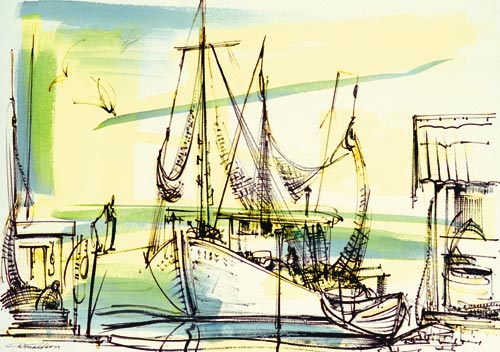
Joe was born in New Orleans on January 30, 1914 - only seven years after the collapse of native Jazz legend Charles "Buddy" Bolden, and a mere five months prior to the assasination of Archduke Ferdinand and the outbreak of war in Europe. Woodrow Wilson had been in the White House scarcely a year. When Joe was a baby, Louis Armstrong was out on the streets of the city selling newspapers, or perhaps unloading cargo down at the docks - he did not yet own his own instrument. I know little about the first twenty-five years of Joe's life, but according to certain records he studied art at Tulane University, and with Enrique Alfarez. What is clear is that at some point in the mid-1930s Joe went to Chicago to attend the Art Institute, and that while there he traveled many times between the Windy City and the Big Easy by the luck of this thumb.
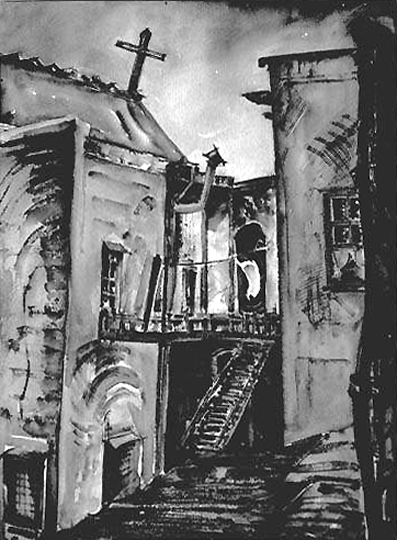
House Behind the Church, 1939
(black and white photo of original watercolor, dimensions unknown)
Exhibited at the New Orleans Art Project Gallery(?), 718 Toulouse St., former
headquarters of the Federal Art Project - see below
(image courtesy of James Baker)
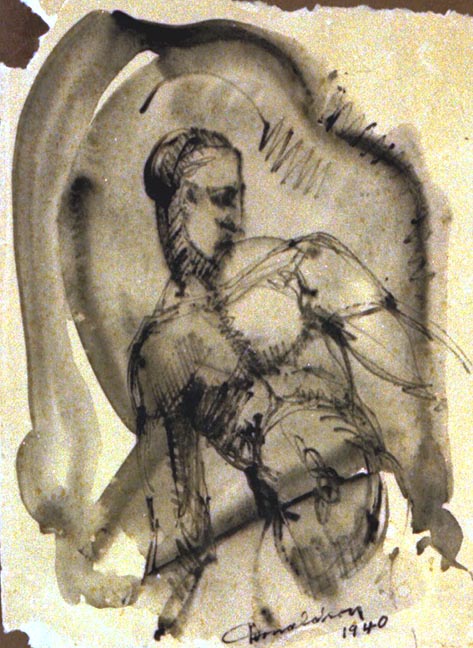 untitled, 1940 dimensions unknown, watercolor and ink (Photo by Tim Manning, image courtesy of James Baker) |
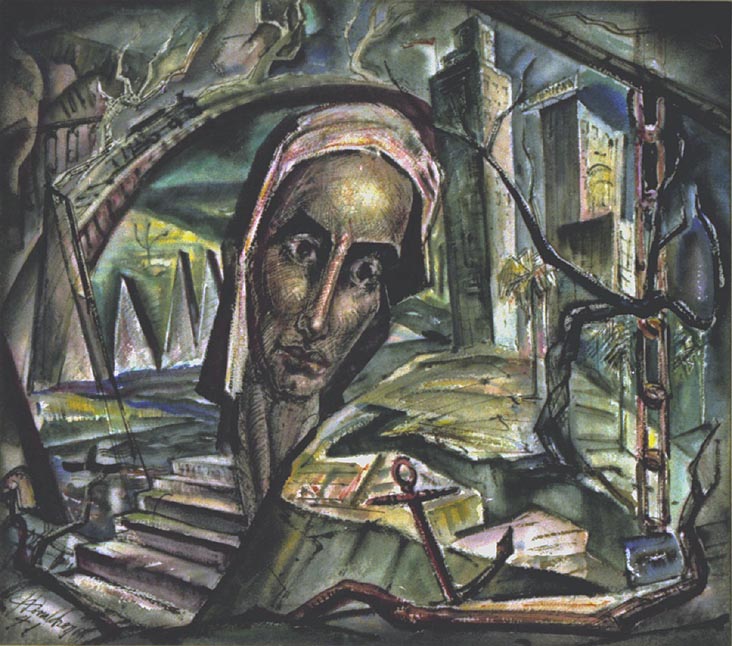 untitled, 1941 dimensions unknown, watercolor and ink (Photo by Tim Manning, image courtesy of James Baker) |
The Works Progress Administration (WPA), established by President Franklin D. Roosevelt in 1935, provided artists around the country with employment and commissions. In the late 1930s and early 1940s Joe was involved with the Federal Art Project in New Orleans, under the WPA.
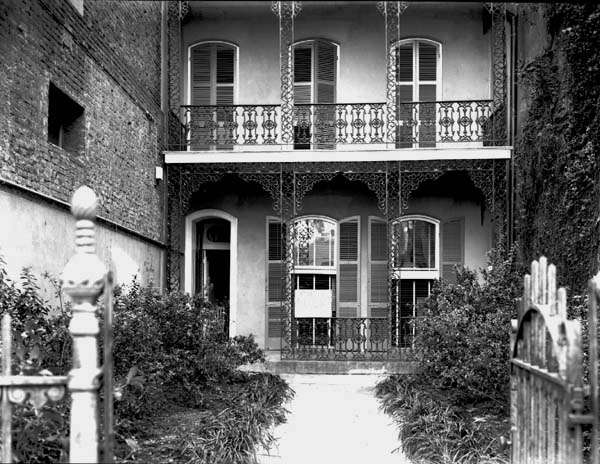 October 26, 1939 - The headquarters for the Federal Art Project at 718 Toulouse Street, New Orleans, originally built in 1889 Joe seems to have spent a fair amount of time here. Only a few doors down the street was the residence of Tennessee Williams. (From New Orleans Public Library, WPA Photograph Collection) (http://nutrias.org/photos/wpa/images/07/07171.jpg) |
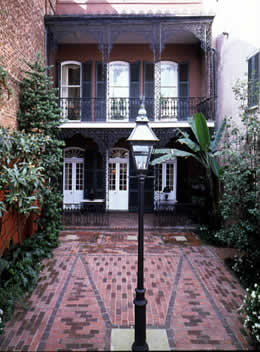 Today the site is a museum, open to the public. The 1939 (original) painting above is apparently exhibited here. (From French Quarter Walking Tour) (http://www.neworleansonline.com/neworleans/fqtour/fq09hnok.html) |
19.75 inches by 15.5 inches, watercolor
(Image courtesy of Buzz Jackson, who received the original from his father, who apparently received it from Joe himself in New Orleans)
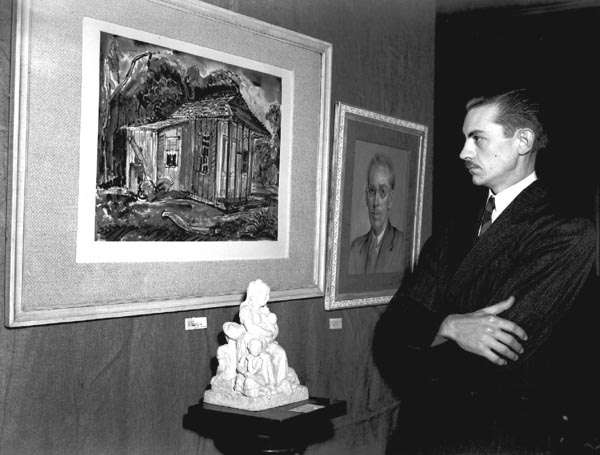
(From New Orleans Public Library, WPA Photograph Collection)
(http://nutrias.org/photos/wpa/images/07/07682.jpg)
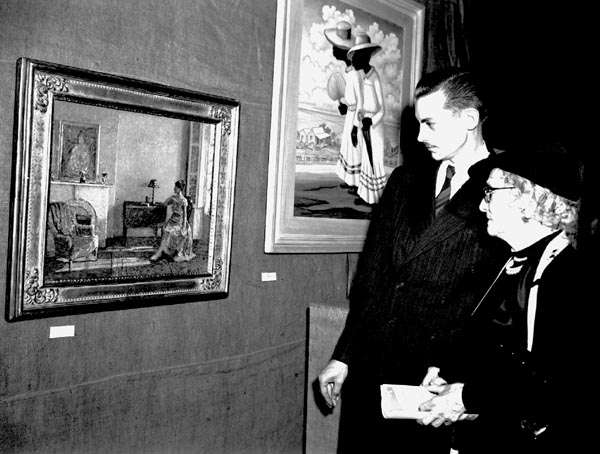 Joe viewing paintings with Helen Turner, November 17, 1941
(From New Orleans Public Library, WPA Photograph Collection) (http://nutrias.org/photos/wpa/images/07/07681.jpg) |
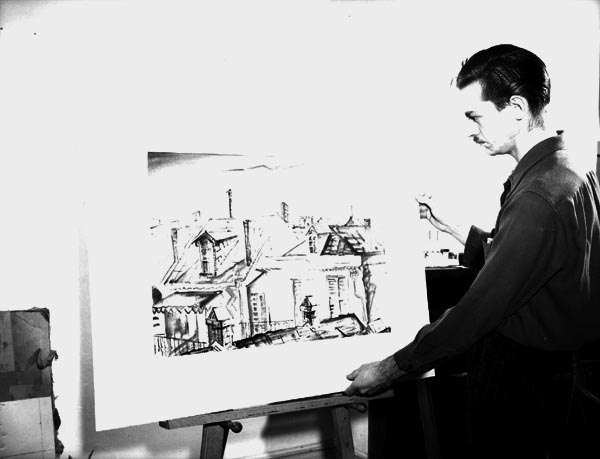 November 17(?), 1941 "Joe Donaldson, Jr., and his water
color drawing,
(From New
Orleans Public Library, 'Sky Line,' which will be on display at the central exhibit for Art Week on the twelfth floor of the Roosevelt Hotel." WPA Photograph Collection) (http://nutrias.org/photos/wpa/images/07/07671.jpg) |
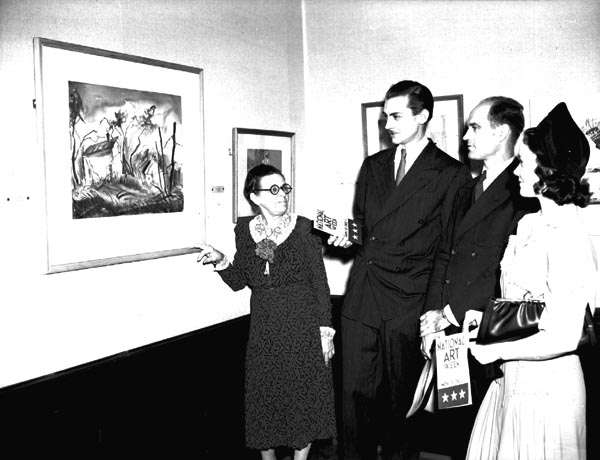 November 24(?), 1941 "Exhibition at the Delgado Museum in City Park During National Art Week" (This may be the 1940 watercolor that is currently in the possession of Buzz Jackson - above.) (From New Orleans Public Library, WPA Photograph Collection) (http://nutrias.org/photos/wpa/images/07/07614.jpg) |
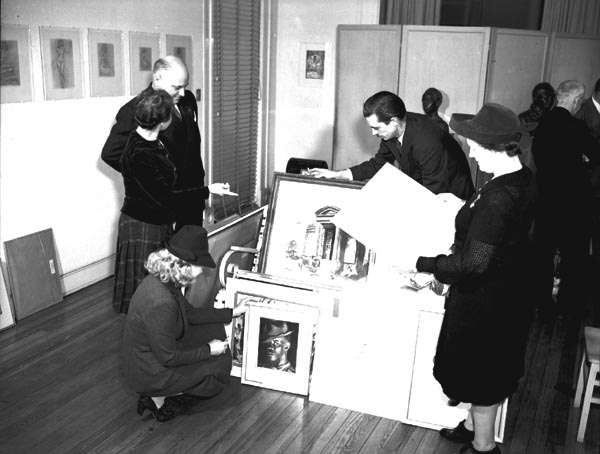 November 17, 1941 "For two daya an art jury selected by the Louisiana committee on Art Week, weighed the works of Louisiana artists to be placed on sale at the central exhibit in New Orleans." (From New Orleans Public Library, WPA Photograph Collection) (http://nutrias.org/photos/wpa/images/07/07652.jpg) |
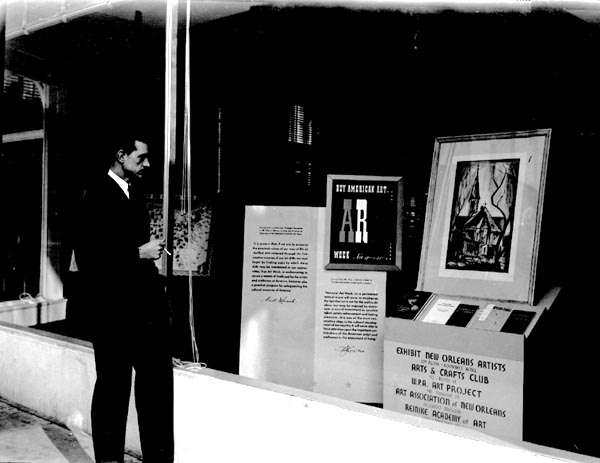
November 17, 1941
"The announcement by National Art Week chairman Thomas B. Watson that his IBM would buy one painting
and one piece of sculpture from each state injected a competitive spirit into the observance.
Louisiana's winner was a WPA artist, Joe Donaldson, who was paide [sic] $50 for his water color, 'Gretna Gothic.'
The painting was placed in the New Orleans IBM office building window where Donaldson was 'caught' by a photographer."
(From New Orleans Public Library, WPA Photograph Collection)
(http://nutrias.org/photos/wpa/images/07/07511.jpg)

Copies of this poster, in various sizes, can be purchased at: www.rainfall.com/posters/WPA/1690.htm
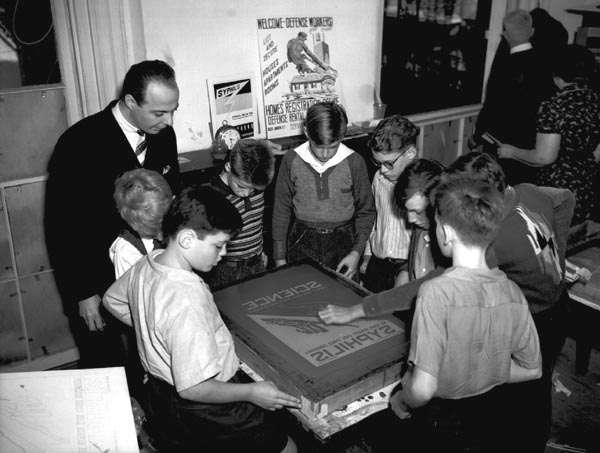 November 17, 1941 "Students from the Metairie Park Country Day School are being instructed by Hans Wang, WPA artist, in the use of a screen for poster making." (From New Orleans Public Library, WPA Photograph Collection) (http://nutrias.org/photos/wpa/images/07/07821.jpg) Joe's poster can be seen here - behind the students |
 The Library of Congress is selling T-shirts and sweatshirts with this design on the front. Contact the management (wood@med.akita-u.ac.jp) for directions to the government site. |
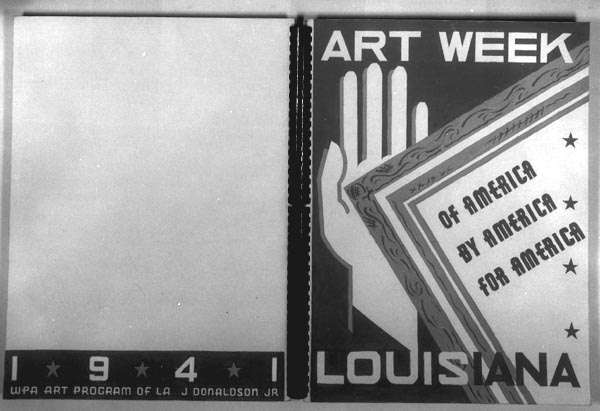
Another piece that Joe did for the WPA Art Program of Louisiana in 1941
Joe's New York Years
This 19 x 27 inch watercolor, painted by Joe during his New York years,
was formerly in the possession of Joy Gaudet Lanneau, who studied art at Tulane U. in the 1940s, and
who later passed the painting along to her nephew, Martin Lanneau.
Photo provided by Martin and Joany Lanneau.
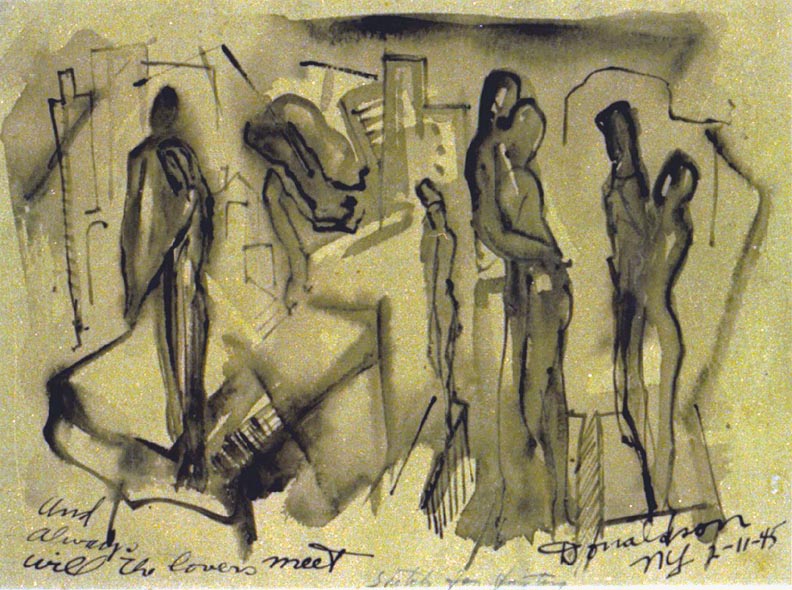 And Always Will the Lovers Meet, February 11, 1945, New York sketch for painting, dimensions unknown, watercolor and ink (Photo by Tim Manning, image courtesy of James Baker) |
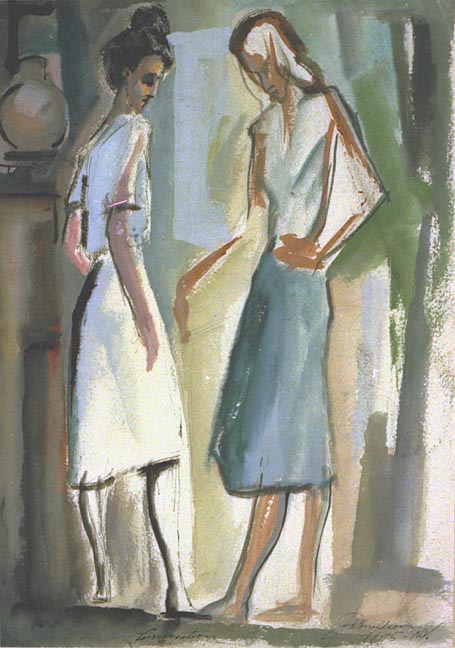 Composition, N.Y., 1945 dimensions unknown, watercolor and ink (Photo by Tim Manning, image courtesy of James Baker) |
These are the only two works executed by Joe in New York that I know of, although there were certainly more
____________________________________________________________________________________________
Joe's Famous Attempted Burglary Story:
(J = story teller - Joseph Donaldson, Jr., D = listener - Donald C. Wood)
J: So then I went to my...I was a civilian attached to the military doing these maps...
D: Right. Yeah.
J: But I had an "essential job" - that's in quotes. By that time there were so many "essential" people we were falling all over (each other)!
And they thought I was an idiot for leaving this job to go...that's...when they were...German subs were blowing the ships out of the water.
So, I...uh...decided I'd do that. But before all of this....and I'm getting my stories...oh, boy.
D: Go ahead. Go ahead.
J: Uh...we were new - Edwina and I - in New York, you see. We loved it, but we were new, and we lived in the Village, and we lived on the
third floor of a...place on Perry Street, I think it was. And it was a small apartment - a sort of a "shotgun" apartment. You could look straight back.
And it was called a "studio apartment" - simply because it had a roll-away bed that you pull out! (laughter)
D: (laughter)
J: When you wanted to sleep you pulled out the bed!
D: Uh, huh.
J: Well, it also had a humongous lamp - an iron lamp - with about a two hundred and fifty watt bulb in it.
D: Uh, huh.
J: And, it was...I had never seen anything like this lamp. So, when we pulled out the bed, we had the lamp by the bed, to read.
Well, I was on the outside, and Edwina was on the inside, and the wall to the bathroom blocked her view of the...of the rear window.
But I could see the rear window. And there was an industrial building which had the lights on all night - its lights on all night - every night,
so illumination was there, I mean, to a degree, I could see. I had twenty-twenty vision then anyway. So, all of a sudden I saw this guy
trying to get in the window!
D: Ah, hah!
J: He had come up the fire escape, to the third floor. This is true. And I never had a gun, and I knew I had to do something, and I had to do it in a hurry.
So I woke Edwina up, and I gently put my hand over her...uh...I did this and smiled. And I was scared to death, but I didn't let her...you know...I didn't
want to frighten her - not that I was ashamed of being scared - anyone who isn't frightened in certain situation is a damned fool! But I didn't want to
frighten her. so, then I, I was only sleeping in a pair of shorts, and I slipped off the shorts. (laughter) And I looked...to see how far the string to this
humongous lamp was - it wasn't far. Then, I ran my hands through my hair, and I had...fairly good length hair, so it stood right up on end. And I
waited until this joker got in the window, with his (laughter) his hands holding the window up - both of his feet inside.
D: Uh, huh.
J: He couldn't reach for a gun, you see?
D: Uh, huh.
J: And I leaped out of...jumped out of bed, pulled on the lamp at the same time, I (was) stark naked, and jumped and yelled at the top of my voice,
and he fell out the window! (laughter)
D: (laughter)
J: He did! (laughter) And Edwina didn't know what...and she had a sheet over her head, and she was jumping and kicking (laughter).
She thought I'd gone nuts, I guess! (laughter)
D: (laughter)
J: Anyway, then...by that time it was almost daybreak - he (had) chosen an odd hour for this attempt at entering, illegal entry. So I said,
"My God, I've killed a man." So I went into the bathroom and combed my hair, and put on my pajamas and my bathrobe. I said, "Hun, will
you put some coffee on?" And she says, "You're going to ask him up for coffee?" (laughter) And I said, "No, no, no. I meant some for us - for me.
I'll do it if you..." and she says, "No, I'll do it." (laughter) So, I went downstairs...service entrance...and sitting there was this little, middle-aged man -
pretty bummed up. And I opened the door and I said, "How badly are you hurt?" And he did a double take and looked at me, and I'm...tall...tall.
I was six four then, and I was about twenty-eight years old. And I said, "I'm the man who's apartment you tried to get into."
He looked at me (laughter) and said, "Mister, for God's sake, either call the cops or go away!" (laughter) So, I didn't call the cops.
I gently shut the door, and went away, and had a cup of coffee with Edwina. And that's the...end of that story. Turn that thing off.
D: (laughter)
J: Kaput!
D: That's the end?
J: ...end of that, yes. Also the end of my voice!
D: Yeah, your voice is sounding...
J: Turn your...thingamajig...off.
______________________________________________________________________________________________________
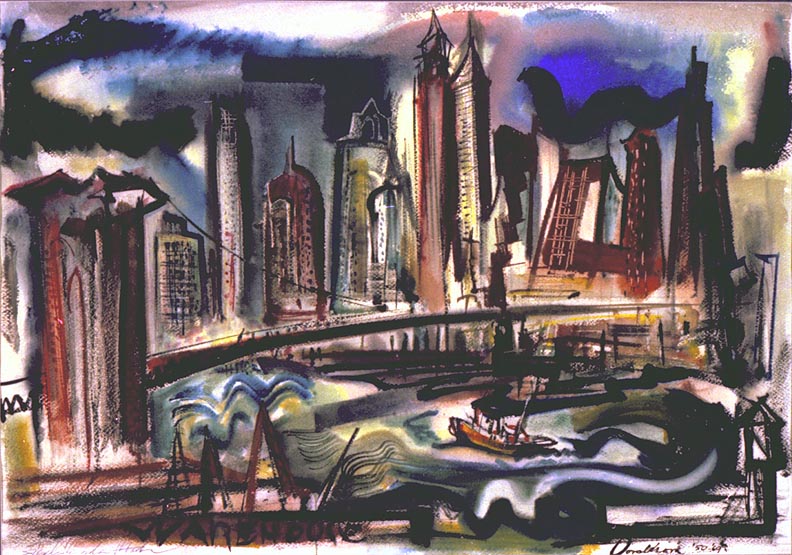 Remembered City, 1950 - 1960 dimensions unknown, watercolor (Photo by Tim Manning, image courtesy of James Baker) |
Revisitation
by Joseph Donaldson, Jr.,
printed in Quartet Magazine, 1971, pp. 26 -27 City
Returned to
After many years Known and unknown - Sharp knife of Strangeness In the Gut And then The bandage-like remembrances And Love City of stench and balm Of Hurt and Humor City of Shrieks and din Of Calmness And Of Truth and Lies This Sea touched Rock based Steel boned Ball hung city-world Rejects My Metaphoric mouthings Simulative words - Accepts confusion Nowness Presence here Action accepts - And Awe |
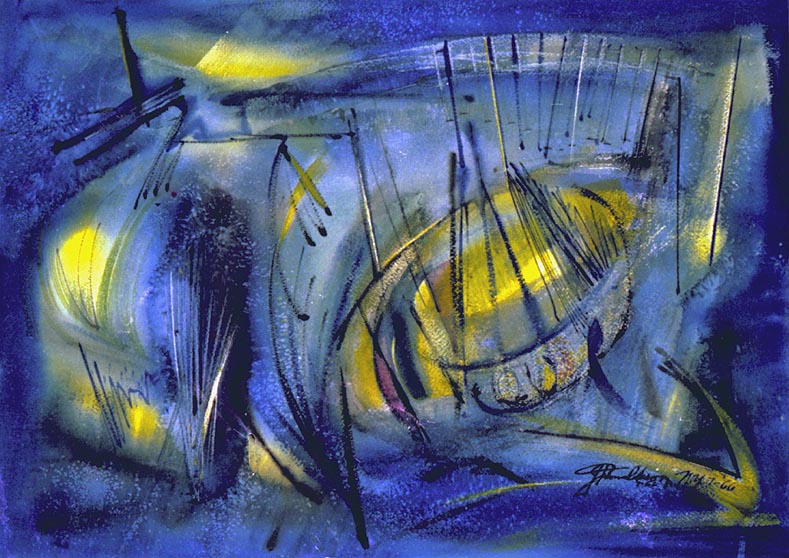
dimensions unknown, watercolor and ink
(photographed by Dr. Tim Manning, Texas A&M University, image courtesy of James Baker)
Certainly Joe was reflecting on the Big Apple when he painted this one as well.
Joe and Edwina returned to New Orleans, and in 1945 he took a teaching position at Tulane University, where also seems to have taught briefly before moving to New York. At Tulane he worked with John Clemmer (see http://www.johnclemmer.com). During this period, back in his home town, Joe exhibited his work with the New Orleans Arts and Crafts Club. At some point - either then or in his earlier time at Tulane in the 1930s - he seems to have been involved with the John McGrady School of Art and the New Orleans Academy of Art, but I do not know anything specific about his associations with either institution. (McGrady was also a WPA artist in the early 1940s).
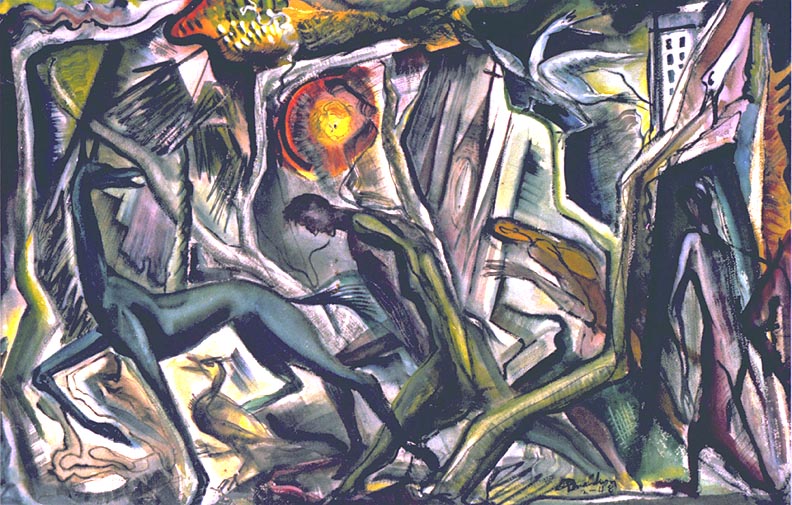
dimensions unknown, watercolor and ink
(Photo by Tim Manning, image courtesy of James Baker)
the famous Japanese avant-garde artist, of the same period.
dimensions unknown, watercolor and ink
(Image courtesy of Todd Maxwell, who was kind enough to photograph this and the
painting below and contribute them. The originals were given by Joe to his father, Gene Maxwell, who was
a student in the architecture department of Tulane University in 1949 and 1950.)
dimensions unknown, watercolor and ink
(Image courtesy of Todd Maxwell)
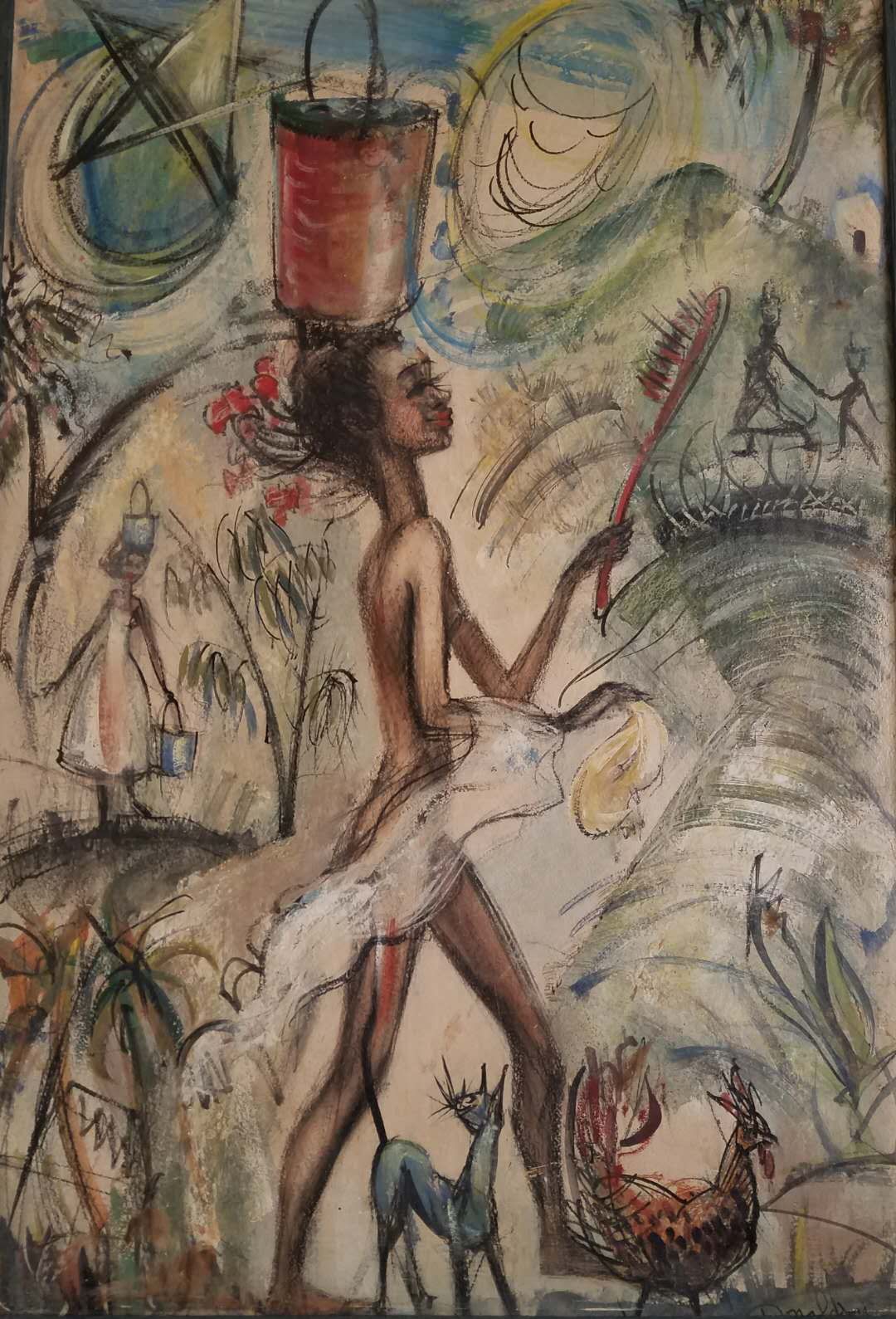
Joe must have executed this playful 2 x 3 foot painting while in the Virgin Islands.
Photo kindly provided by Dennis Headington, whose father appears to have taken a liking to it
after spotting it on the wall of a hotel in the Virgin Islands, and who subsequently acquired it
and took it back to the US mainland aboard the USS Nautilus (c. 1953).
29.5 inches by 19.75 inches, watercolor and ink
(Image courtesy of William Boggess of Oxnard, CA, who rescued the original from someone's garage)
Joe and Edwina eventually divorced after their return to New Orleans. A story recounted by John Clemmer suggests that Joe tried to keep the news of the impending separation from his friends and colleagues as long as he could, and also that he must have been rather anxious about it.
"I recall an incident with Joe in the late 40's. A group of friends and fellow artists were drinking in the Bourbon House. I decided to leave and was asked on what grounds did I have to leave. Apropos of nothing I said on grounds of divorce although I was not married at the time. I was going up the stairs at David Arnold's house on Dauphine St. where I was camped out in the attic when the door bell rang. There was Joe obviously extremely agitated. He vehemently wanted to know what I knew about his impending divorce and whether I had mentioned it to anyone. I had considerable difficulty convincing Joe that I knew nothing about his divorce until he mentioned it and that my parting remark was in response to a question!"
- John Clemmer
Probably around 1950 Joe married Grace Underwood, who had a daughter (Gayle) and a son (Tony) from her first marriage. During his off-time, Joe worked in Grace's attic in order to avoid interruptions. Apparently, Joe's relationship with the dean of the Tulane University School of Architecture was not especially cordial (described by one as "stormy") and this may have been why he resigned in 1951, holding the title of associate professor. Joe and Grace then left the mainland and headed for the U.S. Virgin Islands, where they stayed for five years. There, he taught landscape drawing and painting at the Saint Thomas Art Center. In 1956 Joe was lured away by a friend who was teaching at the school of architecture, Texas A&M University, and he brought Grace with him to College Station to take up a teaching position at TAMU. He later told me that he had made the move because the weather in the Virgin Islands had been "too damn nice all the time." They lived in a small house near the present-day site of St. Thomas Episcopal Church, across a large avenue from the university campus.
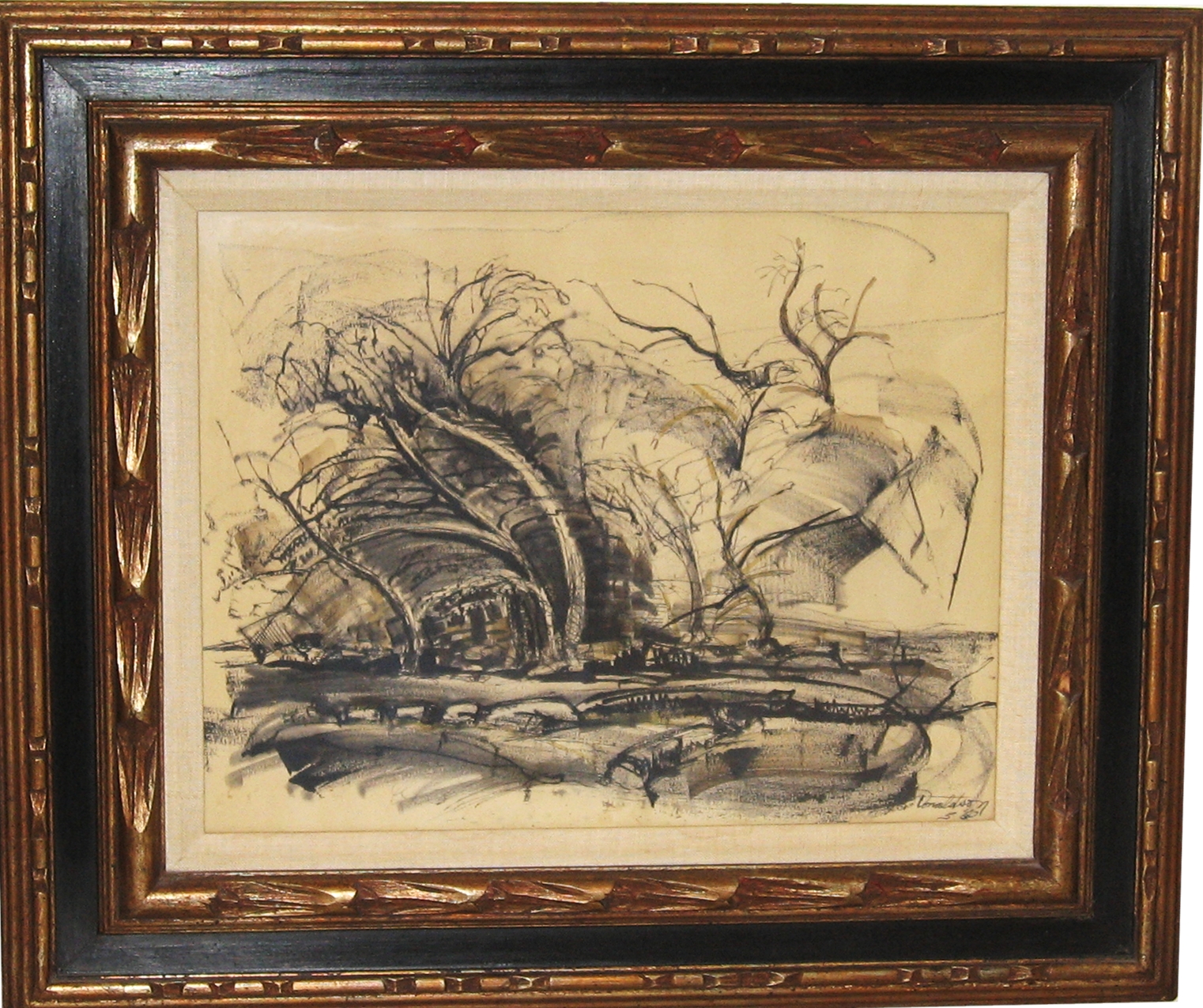
14 inches by 18 inches
(Image courtesy of Sheldon Minkon)

11 inches by 14 inches
(Image courtesy of Sheldon Minkon)
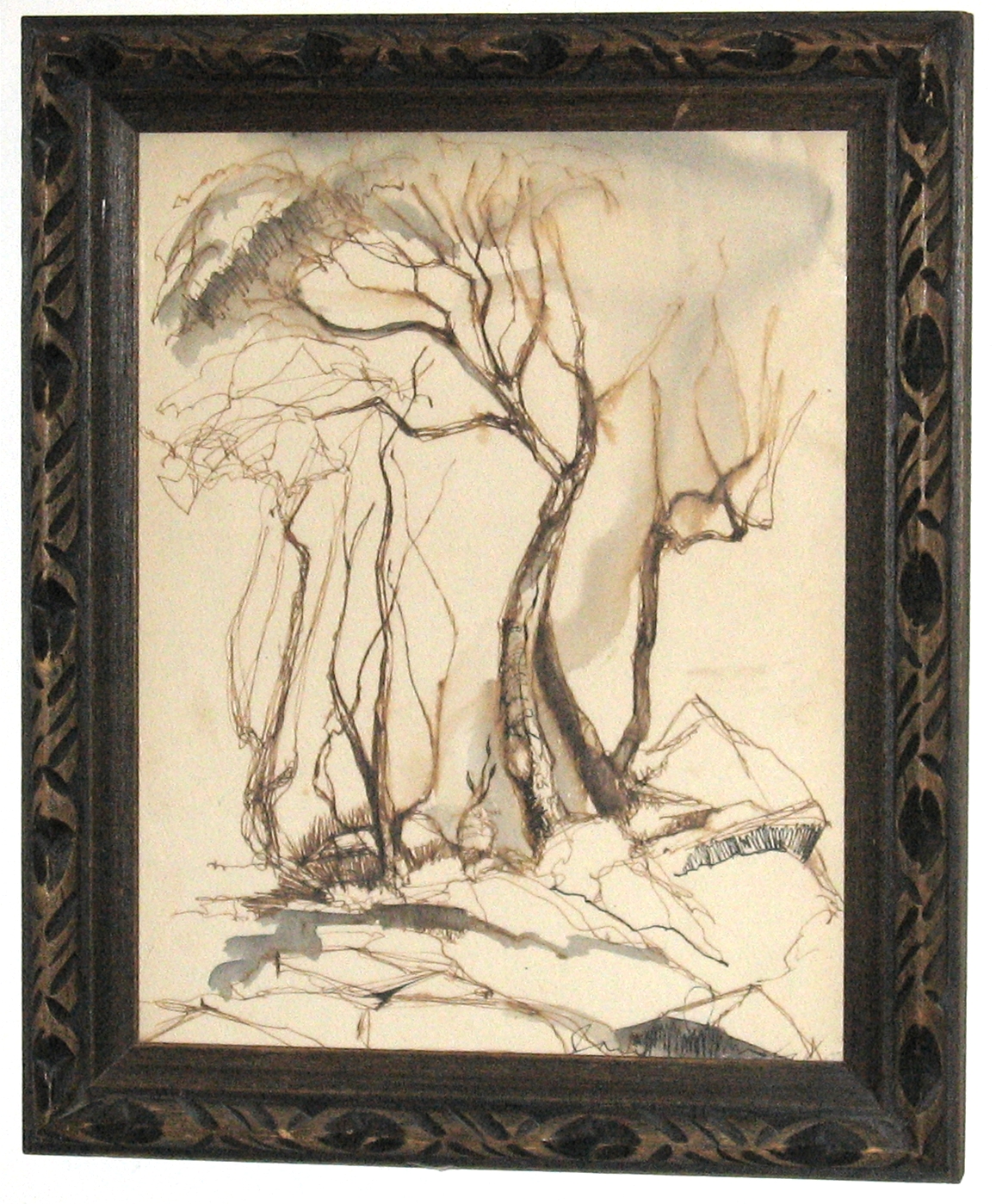
10 inches by 13 inches
(Image courtesy of Sheldon Minkon)
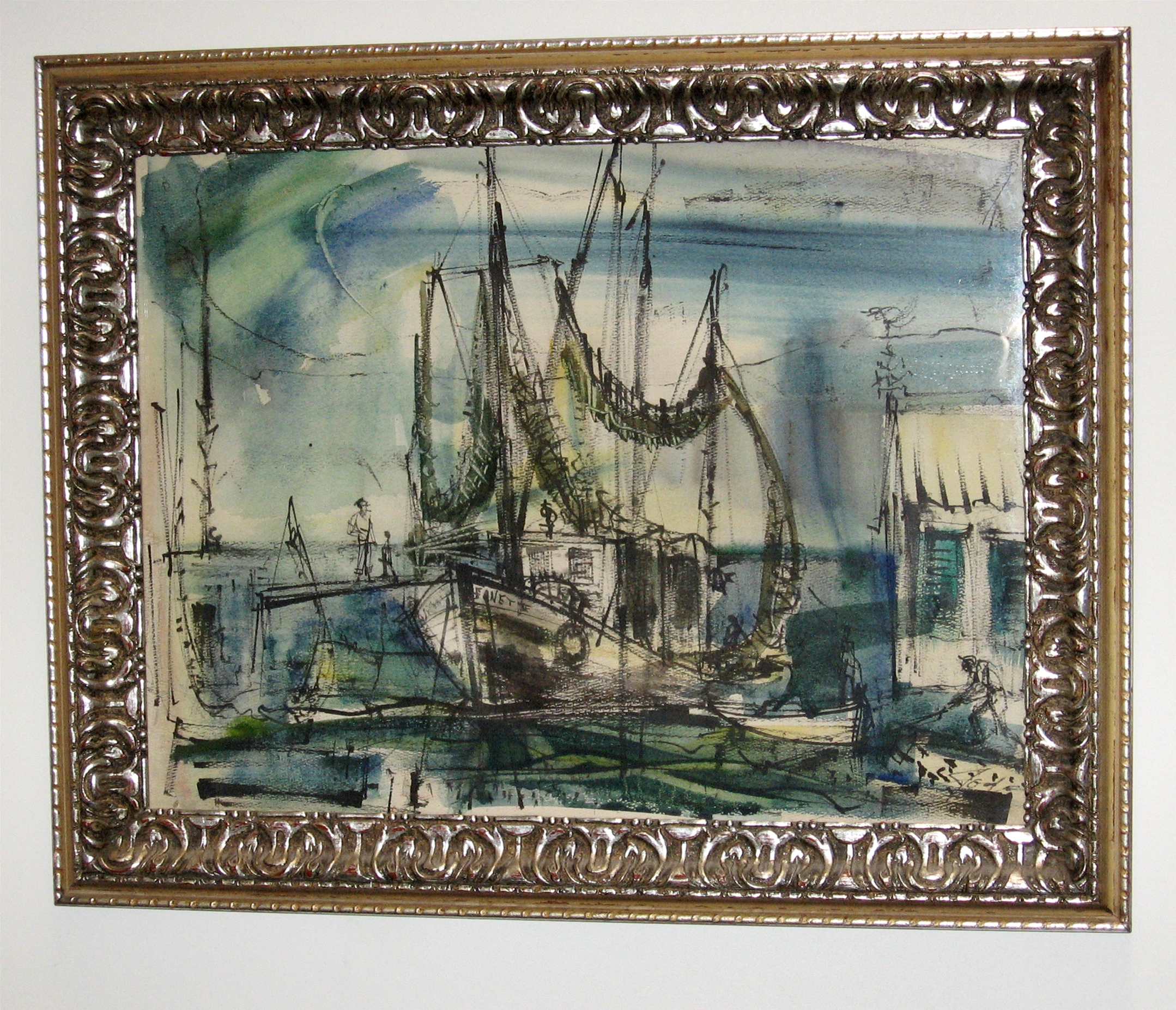
watercolor
(Image courtesy of Sheldon Minkon)
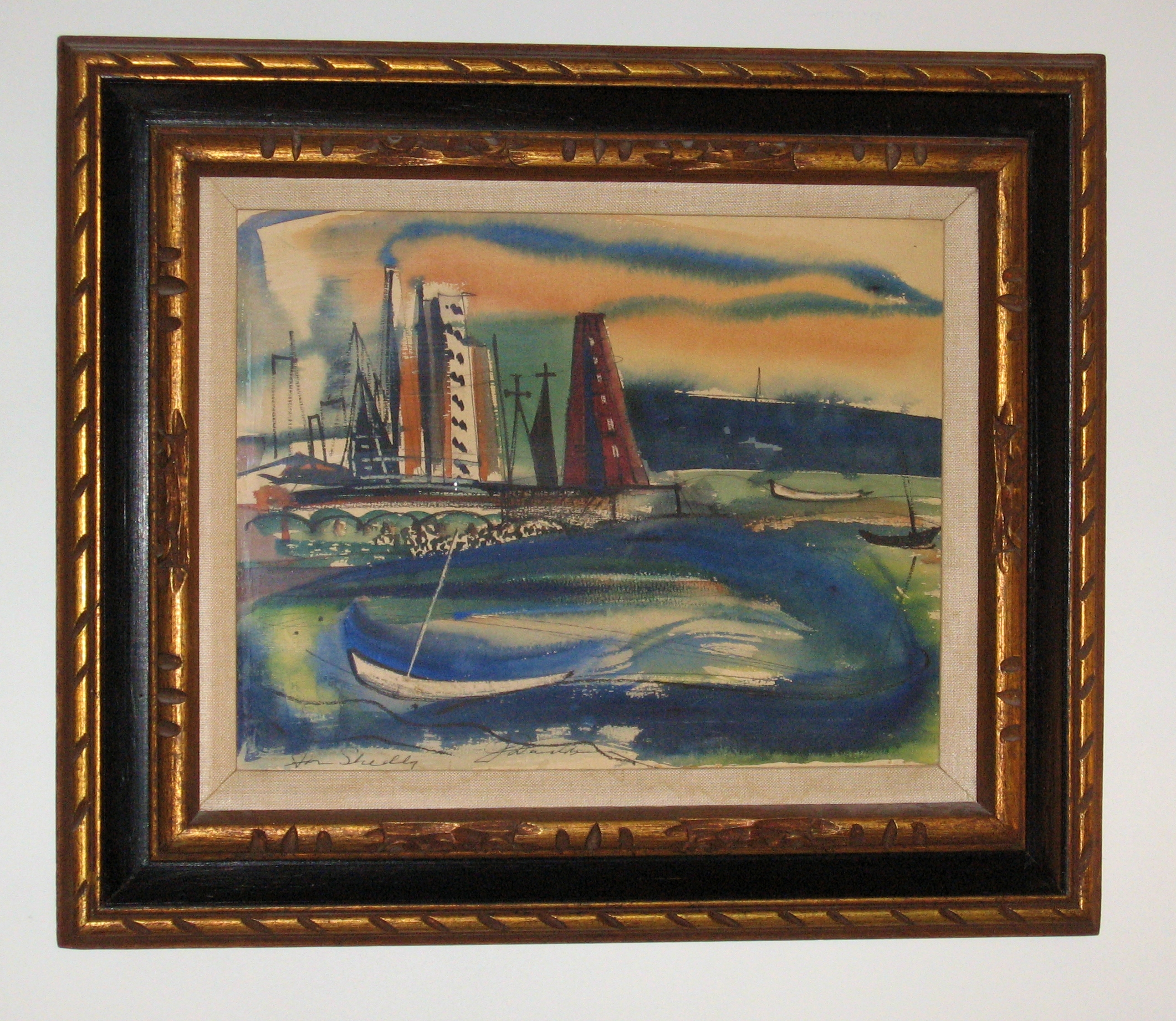
watercolor and ink
(Image courtesy of Sheldon Minkon)
Being somewhat "different" from most other teaching faculty of the university, and from the general residents of the area as well, Joe stood out in College Station; he had just moved from offshore, and was not especially religious (if at all), and was therefore seen as the quintessential Bohemian - a real beatnik. Joe and Grace were known to be fairly heavy drinkers, and night owls as well. In fact, the first half of the 1960s seem to have been an especially rough time for Joe. Sheldon Minkon knew both Joe and Grace at the time, and his recollection helps shed some light on that part of Joe's life:
"I met Joe and Grace in my sophomore year, while a student at Texas A&M school of Architecture. I was very involved and actually living in the Hillel Foundation on Jersey Street (now George Bush Blvd.). The building happened to be close to the Donaldson residence, and I saw Joe frequently. I have to say that by this point in time, Grace was drinking very heavily, and was passed out on most occasions that I was with Joe. By evening time, Joe was not far behind her. They drank brandy, I do not remember the brand, which I would buy, almost daily. I had to drive into Bryan, as College Station was “dry”. [The following] took place, over and over with little deviation. Joe would call me, or walk over to the Hillel Building, drunk and hungry, and ask me to take him to get some dinner. I would take him to some chili joint in “town”, Joe would eat and sometimes, literally pass out, face down, in his plate. Then I would take him home, clean him up and put him to bed. On the occasions that he was lucid, he would insist that I take his art work. We would load my car with drawings and paintings, and the next day Joe would come by and ask for them back. This went on over and over again. I never took the art work out of my car, knowing that he would be back for them. It was like a traveling art exhibit, only in my car. At the end of my junior year I left Texas A&M to pursue a fine art course at Pratt Institute in NY. Joe encouraged me to do this as A&M did not offer an art degree, and I was clearly leaning in that direction. While drunk or sober, Joe was a great teacher, and philosopher. He had a way of getting to the “essence” and was able to translate it to art. I learned much from him, and admired his enormous ability, and intellect. To this day I refer to a book, “the natural way to draw”, that he gave me to help sharpen eye hand coordination. In retrospect, I think that Grace was an alcoholic, and Joe drank to keep her company. I could be wrong, it was so long ago, but based on conversations with friends that new them, I was told that he stopped drinking after she passed away".
- Sheldon Minkon (Sept., 2008)
At one point, Joe later said, Grace was warned by a doctor to lay off the alcohol. He made up his mind to do exactly that, but apparently Grace was not able to - she developed cirrhosis of the liver. The specific reasons are unknown to me, but the couple eventually divorced (whether this happened before or after Grace's diagnosis I also do not know). It seems that Joe spent some time with his parents and his sister's family in New Orleans during this period, and this very well may have been while he and Grace were separated. Back in College Station, Joe remarried Grace, and he took care of her as her condition worsened. He was becoming well-established as a Texas (and generally Southern) artist, and as an educator in the University, by the time Grace passed away on April 2, 1965. Although Joe has apparently not been buried in his family grave, he did have Grace interred there. The tombstone still overlooks the burial plot in Lafayette Cemetery in New Orleans.
IN MEMORY OF ELLEN DONALDSON BORN SEPT. 8, 1848 DIED JUNE 20, 1907 JOSEPH DONALDSON BORN JAN. 18, 1831 DIED JULY 30, 1911 WILLIAM DONALDSON NOV. 19, 1880 MARCH 25, 1964 JOSEPH DONALDSON JULY 10, 1875 MAY 29, 1964 GRACE GRAHAM DONALDSON WIFE OF JOSEPH DONALDSON, JR. AUG. 22, 1912 APR. 2, 1965 ELIZABETH SAWYER DONALDSON WIFE OF JOSEPH DONALDSON JUNE 1, 1883 JUNE 9, 1966 |
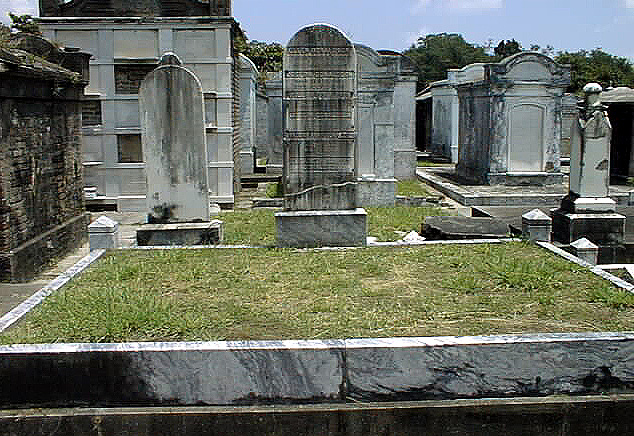 The Donaldson family grave in Lafayette Cemetery No. 1, New Orleans (photo and transcription courtesy of Fred Hatfield - www.fredhatfield.com, lafayettecemetery1.com, under "Donaldson") Ellen (Philipps) and Joseph were Joseph, Jr.'s grandparents. William, his uncle, married Flourisca Webber in New Orleans on March 17, 1906. The second Joseph was Joe's father. He married Elizabeth Thomas Sawyer, who would later give birth to Joseph, Jr., in New Orleans on April 22, 1908. Joe Jr.'s sister, Elizabeth Ellen Donaldson, was named after the siblings' mother and grandmother. She married Richard Leonce Buck, a surgeon, in the 1930s and died in 1980. Her son, Joseph Donaldson Buck, Sr., still lives in Louisiana and contributed material for the museum. |
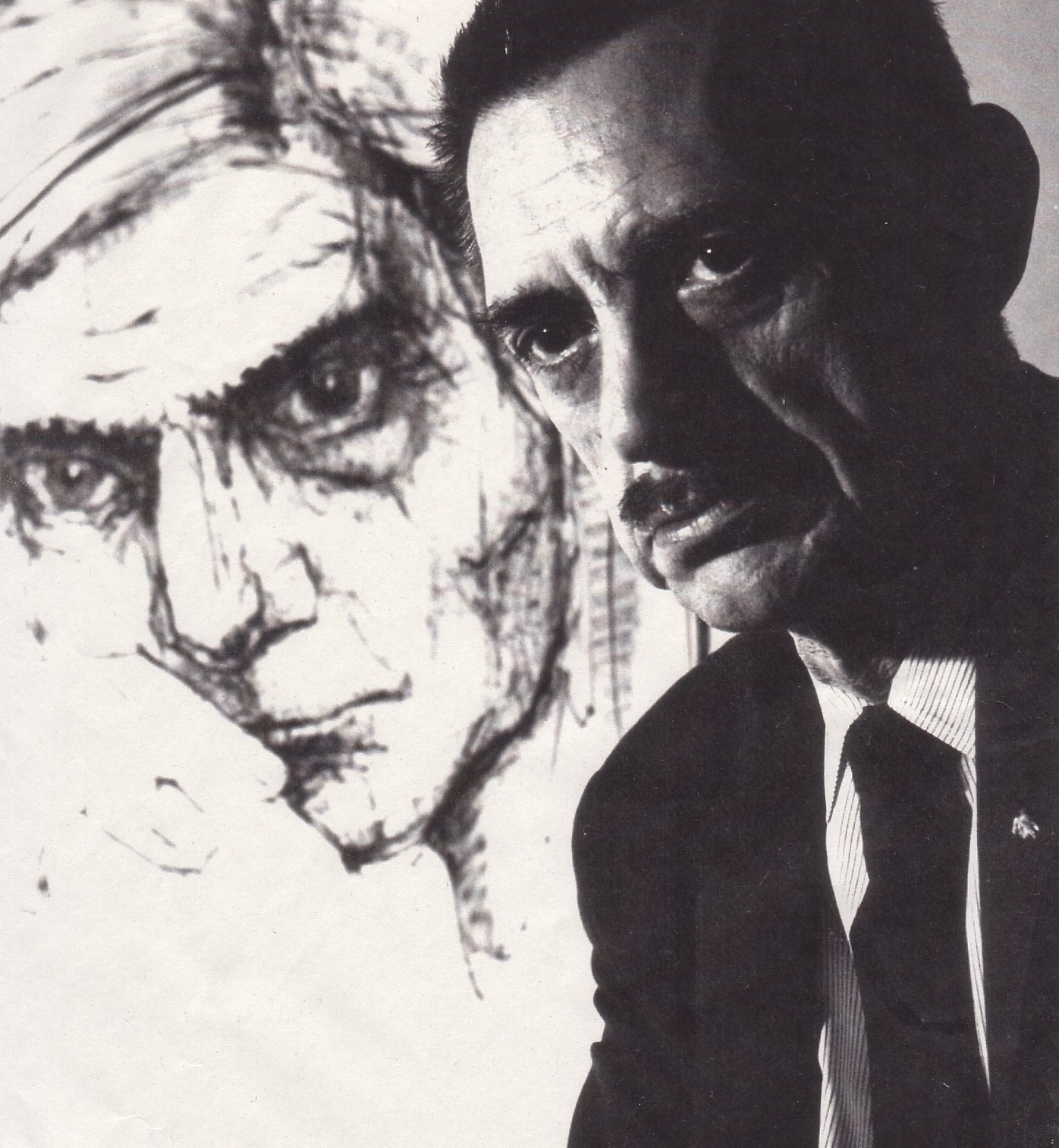
1965 Portrait of Joe Donaldson by Dan Malcolm,
TAMU class of 1963
(courtesy of Dan Malcolm)
"I am so pleased to [share] send this photo of Joe. I took this sometime in the fall of 1965 for a specific reason. As part of my course work, I took a photography course (all 5 of us in the graduate center did) and we were to have a photo contest on campus with five or six other schools to attend. I asked Joe if I could take a portrait photo of him and he agreed. We agreed on a time, and I believe I took this in his office. I had a double lens Yashika camera, a tripod and a small aluminum hooded hand held flood light with about a 40 watt bulb in it. That's all I could afford. If you knew Joe, you know he could never be still. I knew it was going to be a challenge to get him to sit still for a portrait. I knew I was going to have to work fast, and I did. The entire session probably took less than five minutes and I don't think I got more than 3 or 4 shots. The image in the background is an ink drawing that Joe did of Alan Stacell. I got lucky. What a shot. I took first place in portrait in the photo contest! I felt then and feel now that this photo really captured the true character of Joe Donaldson."
- Dan Malcolm (2007)
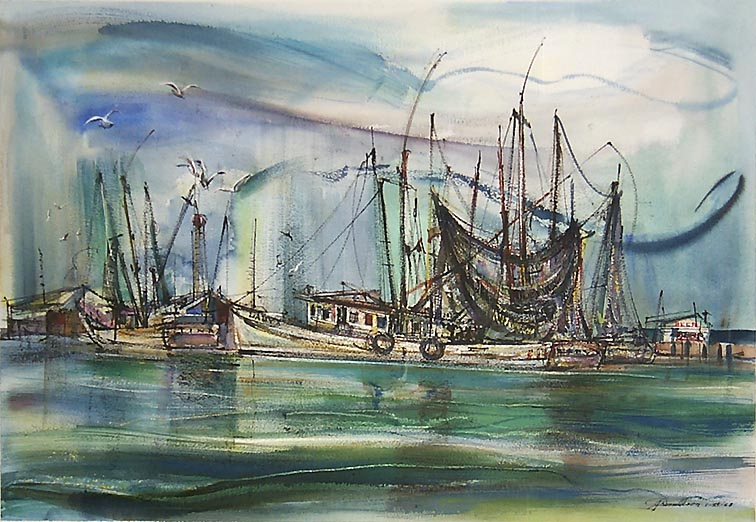
Gulf Shrimp Boats, 1968
19 inches by 27.5 inches, watercolor
(Image courtesy of James Baker, original in a private collection)
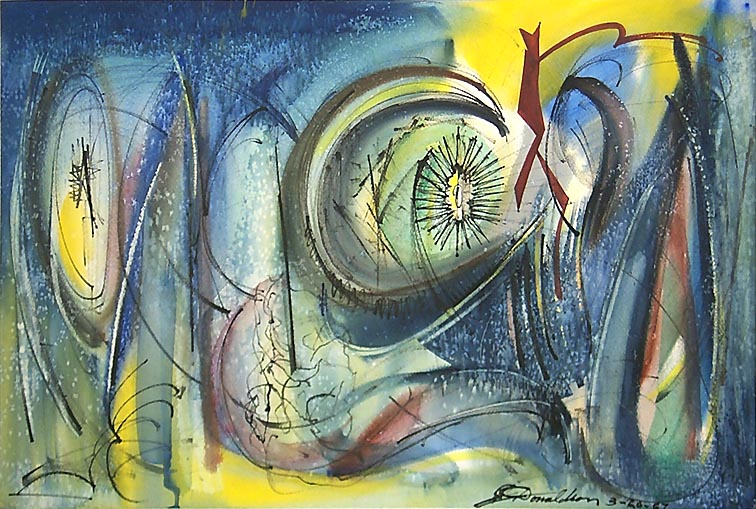
Abstract, 1967
18.5 inches by 28.5 inches, watercolor
(Image courtesy of James Baker, original in a private collection)
"The last time I saw Joe was in 1993 when I went to school for our 30th reunion. I had not seen him since 1966 or '67. That is the time he talked about when he saw so many of his students who had called him "Conte Joe". I think my class gave him that name. Joe was standing on the sidewalk near the architecture building. I walked up to him and said 'Joe, how are you?' He said 'Dan Malcolm!'. After 25 or 26 years, he still knew me. Then and there, I knew I was more than just one of his former students, I was his friend."
- Dan Malcolm, '63
Joe also had pets: an Afghan hound named "Tasha" that lived to the age of seventeen, and later a fluffy cat whom he affectionately named "Mr. Wussy." Sadly, however, Mr. Wussy vanished one day, never to return. I was still in my mid-teens at the time, and so was not particularly interested in the old man yet, but I remember that the feline's disappearance upset Joe very much. My mother made some signs that read "Help Find Mr. Wussy," and posted them around the neighborhood. She also searched far and wide for that cat, and for my part I recall at least keeping my eyes open. Joe never got another pet after that. In the end, although Joe married a total of five times in his life (twice to the same person) he never became a father. I guess his drawings, paintings, and poems were his children.
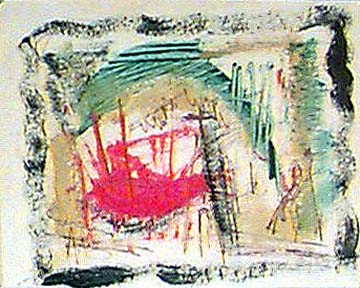 Abstract Composition, date unknown 4 in. by 5 in., mixed media (Image courtesy of James Baker, original in the collection of Graham Horsley) |
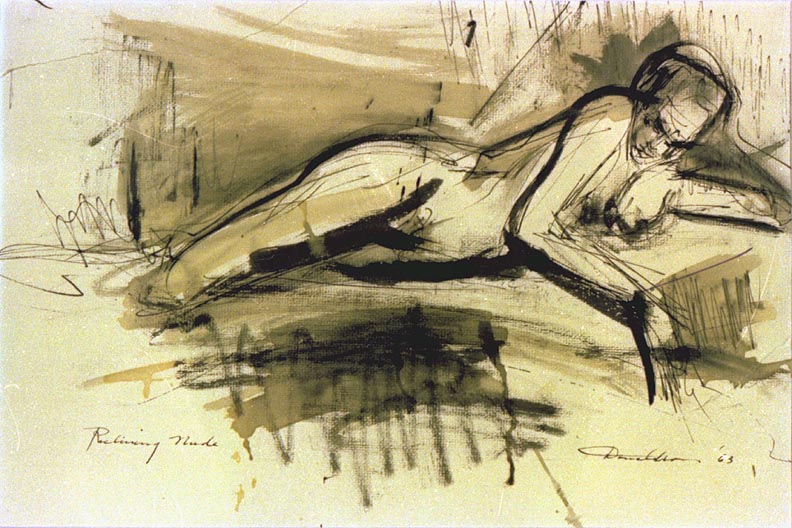 Reclining Nude, 1963 dimensions unknown, watercolor and ink (Image courtesy of James Baker) |
I grew up in College Station and knew 'Conte Joe' as a neighbor as well as a professor. I grew up on Lee Street about 2 blocks from his house on what then was Jersey Street. It is now George Bush Avenue. Joe lived in a small green house next to the Episcopal Church and was (...) a bit unorthodox in his ways. I came to know this thru Alan Stacell, a coworker in the Architecture Department and also a member of the church as well. I ended up in the LA program at TAMU as my dad wanted me to work in a field that was more stable than pursuing art, which was my first love.
In public school I had studied under a local painter, Ruth Mogford and as luck would have it, some other local artists. But I recall that in high school I really wanted to take from Joe and learned that on some occasions he give private lessons. He and I talked and he agreed to consider it if I would help him clean up his studio in the house. I remember spending hours in his small studio going thru stacks and stacks of sketches and paintings trying to decide what he might want to part with (discard) and what he would keep. He was too busy to sit by my side and go thru them so it became my task to try and organize them. It was a hopeless effort. Everything I saw looked wonderful and the ones I thought he might part with he wanted to keep.
I do remember a mountain of the napkin sketches and numerous bird sketches he described as portraits of persons that appeared "pompous and overbearing", alluding to how rich in art opportunities, drinking coffee and people watching were. He would do these with a wooden match stick and a bottle of india ink. What amazed me about his work is that it was quick and decisive with never an errant stroke. This is the time when he was publishing some things in Ford Times and I was very impressed. Anyway my employment was brief as he realized he would have to do the work himself. So my hopes of private lessons never evolved.
I truly began to understand his talent and teaching ability, spending time in his sophomore level graphics class. One nice thing about him was he did not mind if students from other sections and classes wandered thru his labs. We focused primarily on the use of conte’ crayons and some ink washes. I remember a series of quick figure studies whereby we had to work very quickly and sometimes without lifting the crayon from the paper. It took some of the anxiety out of the process of creating.
I also had the opportunity to study under Alan Stacell, Roy Pledger, John Fairey and others in the department. It was the only art in the community and it was a great opportunity for me. I also got to spend some time with E. M. "Buck" Schewitz a successful artist in his own right. He did workshops at A&M on occasion.
- Bruce Riggs, a former student of Joe's at TAMU
"Joe would draw on anything available, anywhere we were, napkins, placemats, paper scraps he found. He usually dismissed them as junk and tossed them. I wasn't smart enough to keep them. With me, he was always demonstrating, and teaching me something through those sketches."
- Sheldon Minkon (Sept. 2008)
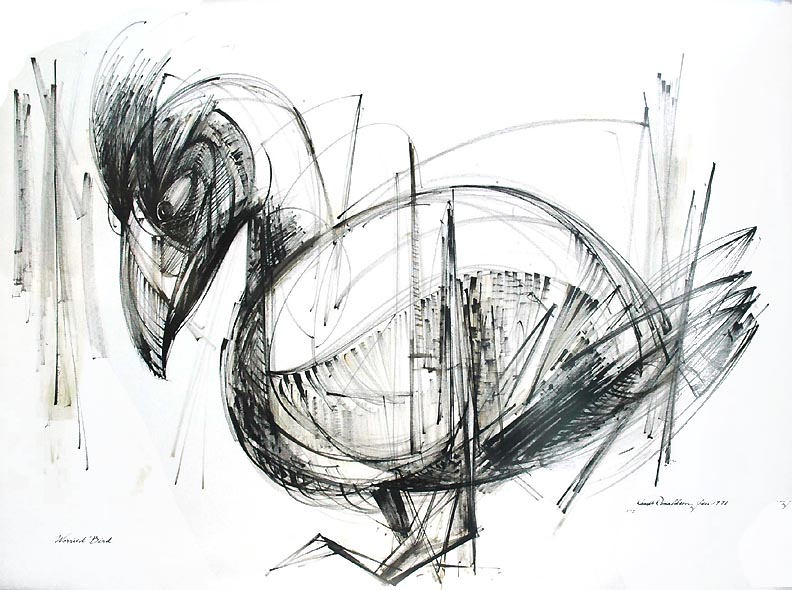
30 in. by 40 in., conte crayon, charcoal, and ink
(Photo by Megan Taylor, image courtesy of Ken Zindler, via James Baker)
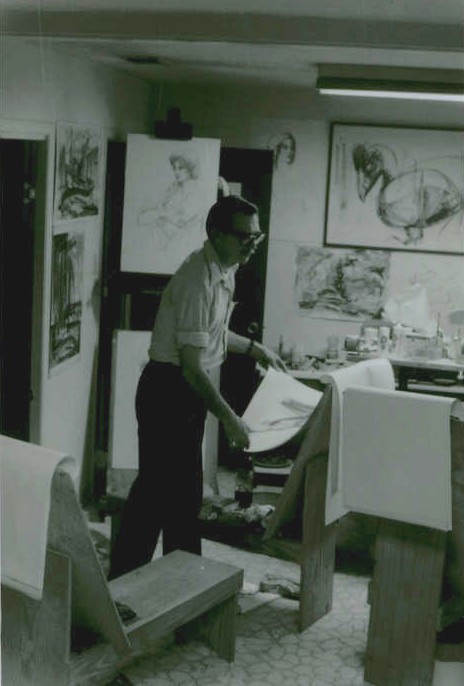 |
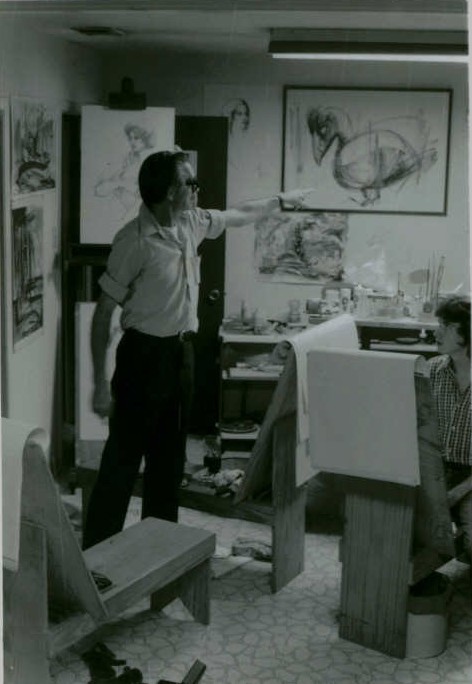 |
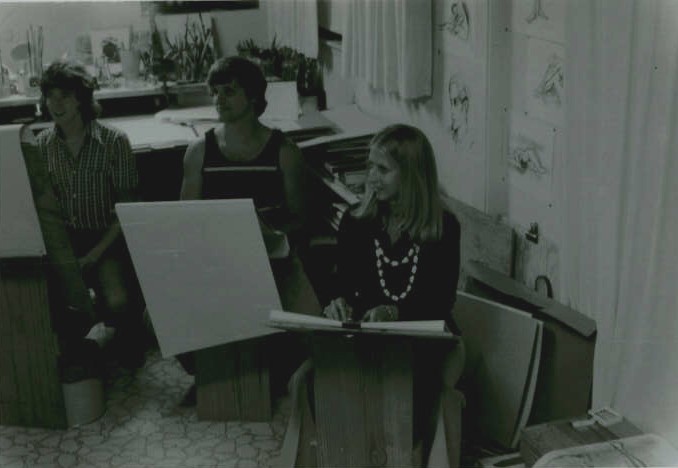 |
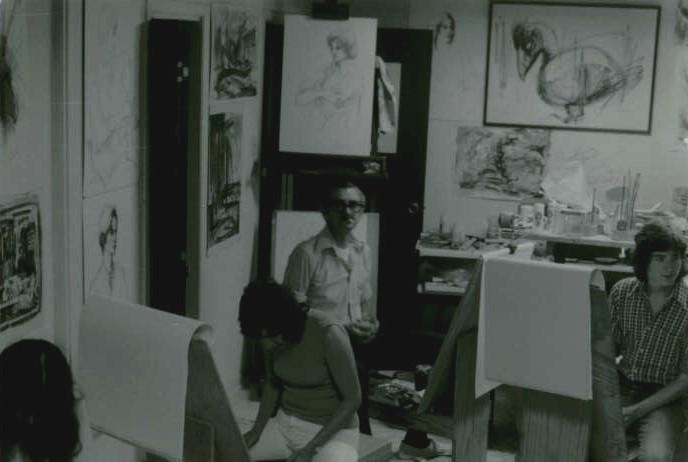 |
My mother, Katherine Wood, sits in the foreground of the photo on the bottom left. Nelson,
one-time lodger of Joe's and the model for a portrait (and possibly two) in the portrait gallery, is visible in three of the photos.
(Images courtesy of Katherine Wood)
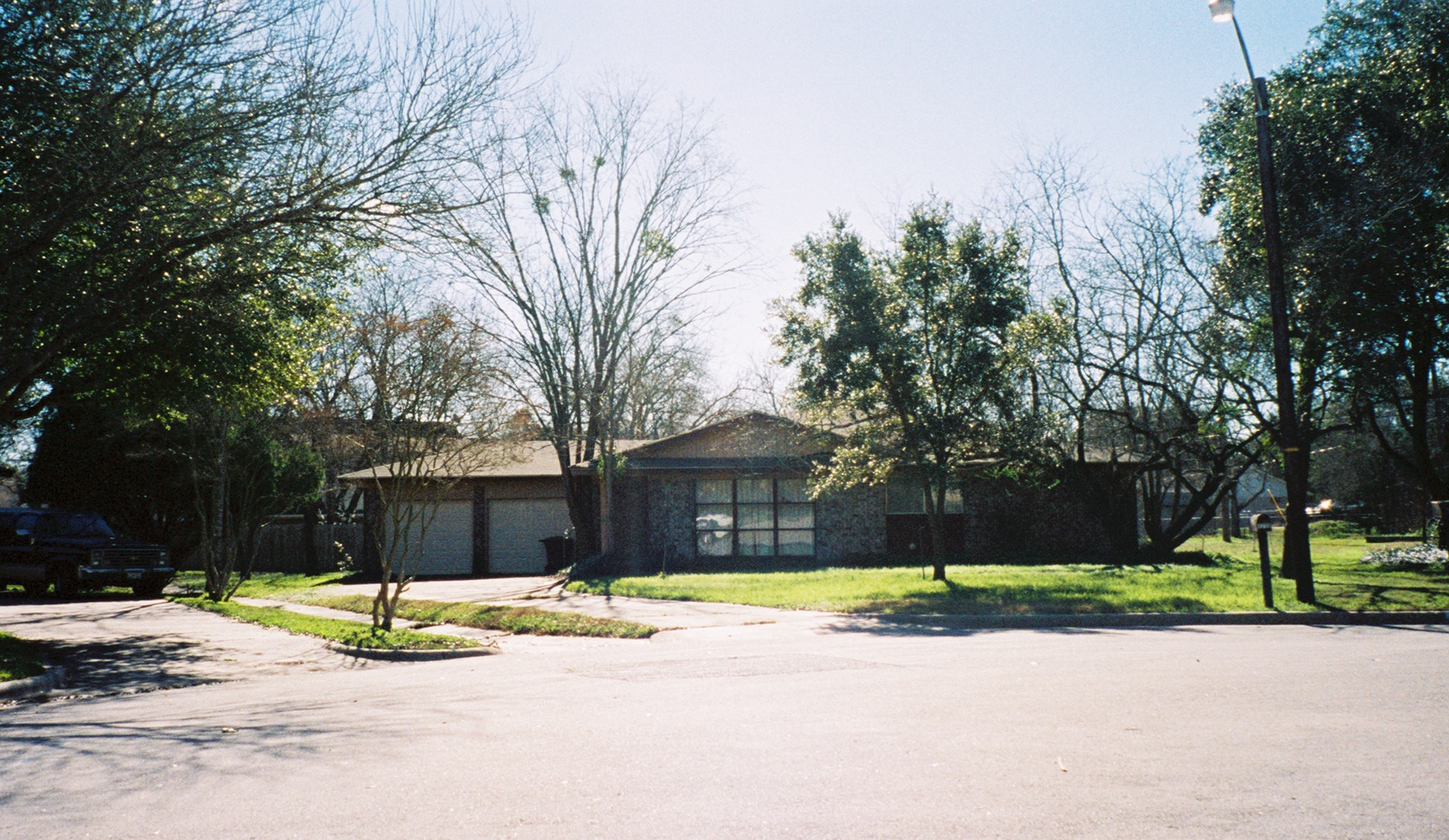
The room in front was Joe's studio.
(photographed in 2005 by Katherine Wood)
As can be seen from the above photo, from the outside Joe's house looked just like any other, but on the inside it was totally different. It was like a small art gallery - the walls were covered both with his own works and with those that his students had given him over the years. It was wonderful to just sit and chat with him, surrounded by all the paintings, drawings, and sculptures. In the center of the living/dining room was a huge, thick wooden table with all kinds of interesting objects - driftwood, stones, glass beads and marbles - on it, and on the north side of the house was his studio, complete with a stage for models to perch themselves upon, easels, tables, and a fantastic collection of tools for his trade.
Joseph Donaldson -
artist, professor, and writer - has sought through
many avenues of expression and communication to
share his love and understanding for the arts with
generations of students, as well as colleagues,
friends and his several "publics", from Houston to
New York and Cardiff to St. Thomas.
He brings to
his art, teaching and writing the knowledge and
expertise of one widely traveled and diversely
schooled - from his early student years in his
native New Orleans, at the School of the Art
Institute in Chicago, through a stimulating period
as a painter in St. Thomas, the Virgin Islands, to
his more recent and varied experiences in western
Europe while on faculty development leave from
Texas A&M University.
Relating his
experience as a practicing artist to teaching art
has been a major preoccupation, and yet he also
exhibited his work widely in many major national
shows in New York, Chicago, and New Orleans, as
well as regional and state exhibitions in Houston,
Dallas, San Antonio and Austin.
Additionally, his work is represented in numerous
prestigious public collections such as Ford Motor
Company, International Business Machines, Inc.,
the Hazel Guggenheim McKinley Collection and
Government House, St. Thomas, Virgin Islands, as
well as many private collections – Burl Ives, New
Orleans, Amy Freeman Lee, San Antonio, and Charles
Colbert, New Orleans. Further,
his commissions include the Sazerac mural,
Roosevelt Hotel, New Orleans, illustrations for
“Ford Times” and “The Continental Magazine”,
illustrations and poems for “Quartet”, a magazine
of the arts, design and illustrations for Frances
Parkinson Keyes’ “Dinner at Antoines”, short story
illustrations for “Southern Magazine”, book jacket
design for Bantam Books, New York and color
consultant for L. Lanzer “Multi Map, Inc.” (world
maps for high school and college textbooks), New
York.
While he is
thoroughly conversant with what is happening in
the world of visual arts today, he feels no
compulsion to be a part of the so-called “leading
edge” of any movement or “ism”.
It is indeed reassuring to find a man with
such absolute integrity who knows himself as well
as Joseph Donaldson does. He
makes his art as naturally as he breathes,
nurturing his own skills of mind and hand, while
enriching and stimulating all with whom he comes
in contact.
He is an individual
whose credentials as a human being, artist and
teacher more than qualify him for the recognition
and honor which this select retrospective
exhibition accords him.
written by the late W. Graham Horsley, Professor of Environmental Design and long-time friend of Joe's
(The "Sazerac mural" mentioned here is not, in fact, displayed in the Sazerac Bar in New Orleans. All of their
paintings were done by Paul Ninas in the 1940s. John Clemmer, however, did have a study for a mural that must have been
intended for the Sazerac Bar but was never executed. It now belongs to the Historic New Orleans Collection.)
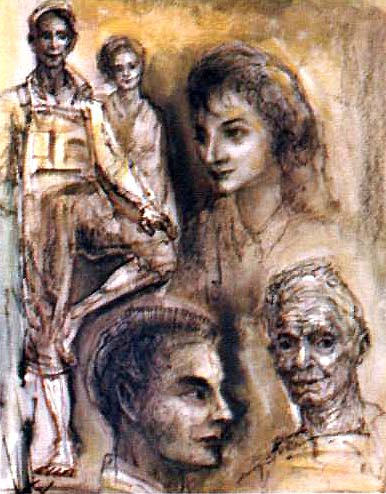 Faces of the Big Thicket |
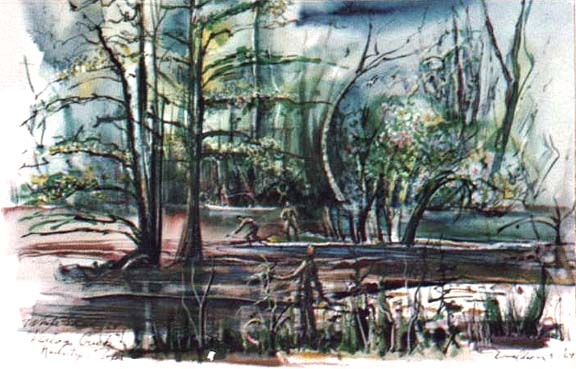 Village Creek 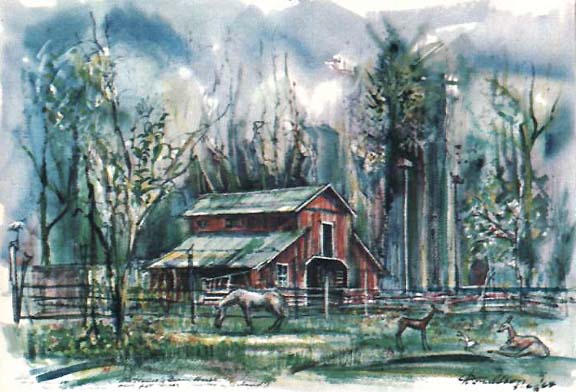 Farm on Honey Island, Big Thicket |
Various illustrations for "Jungle Country - Texas Style" by Archer Fullington,
Ford Times Magazine, November 1964, pgs. 41, 43
(Images courtesy of James Baker)
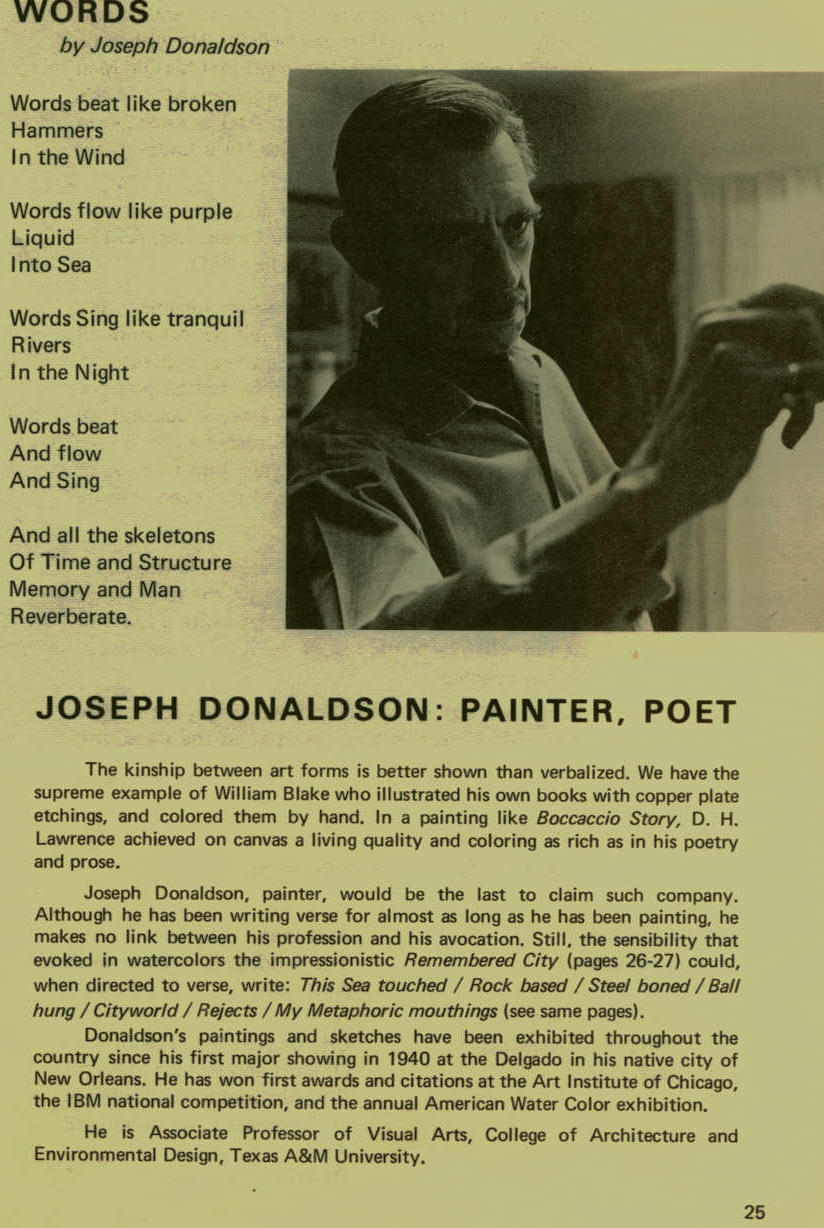
(Image courtesy of Katherine Wood)
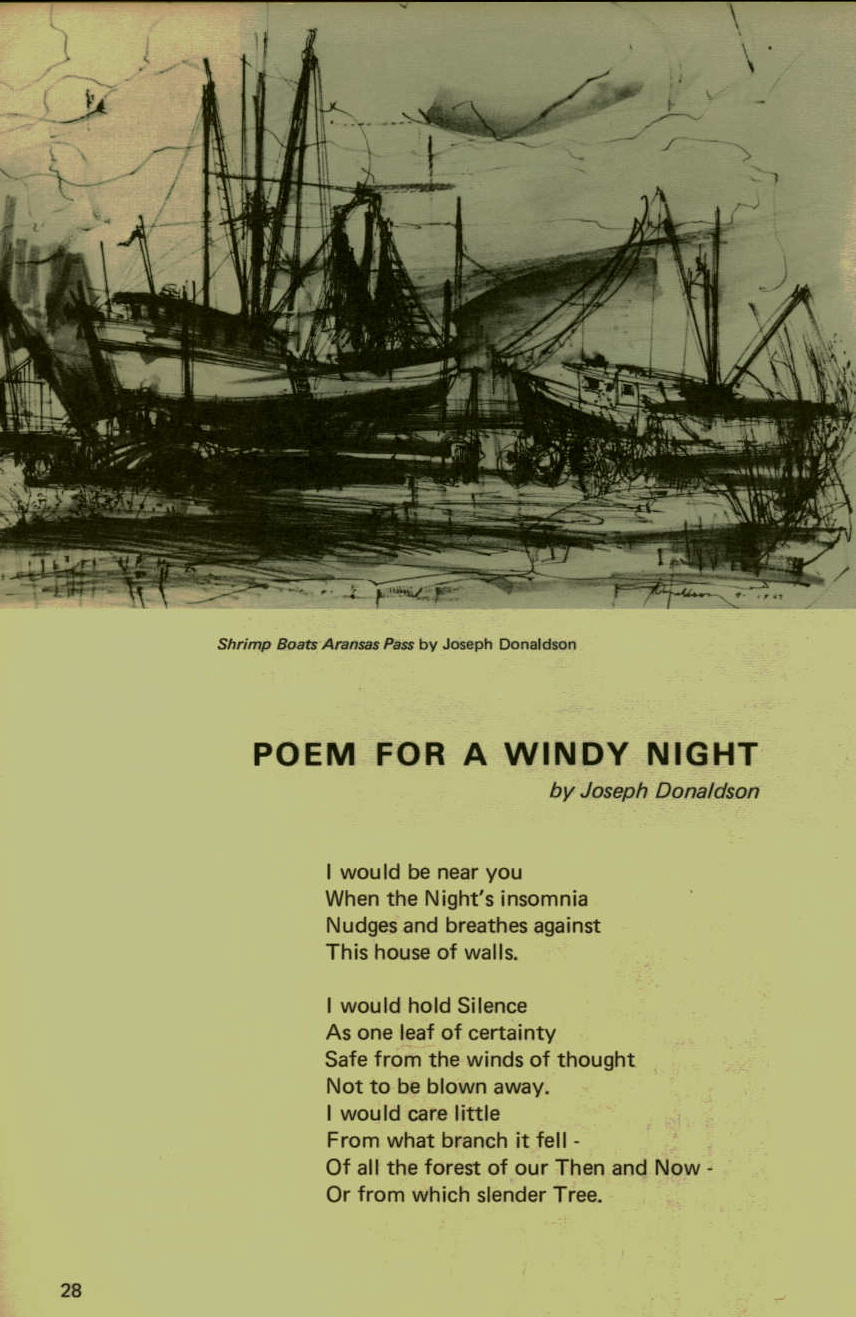 |
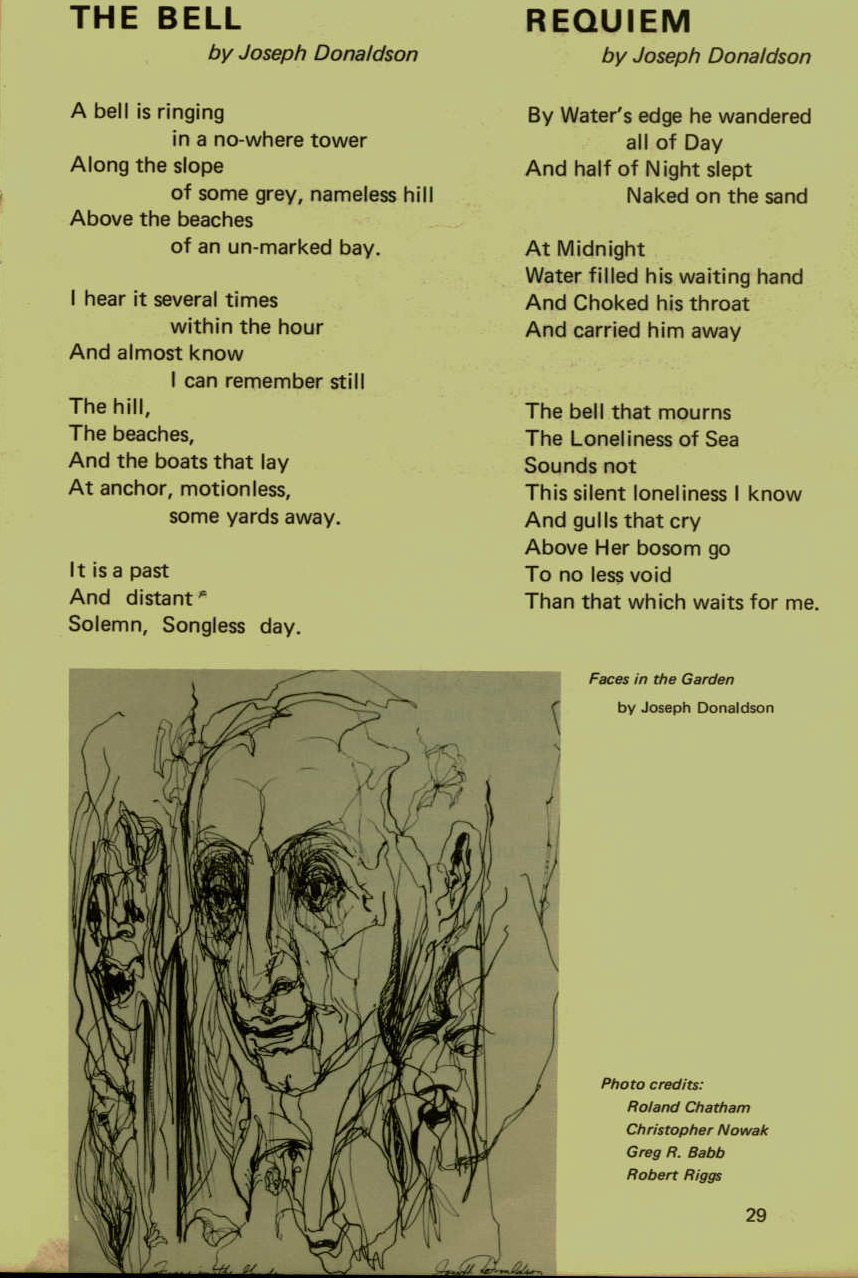 |
(Images courtesy of Katherine Wood)


Shrimp Boats at Seadrift, Texas (n.d.)
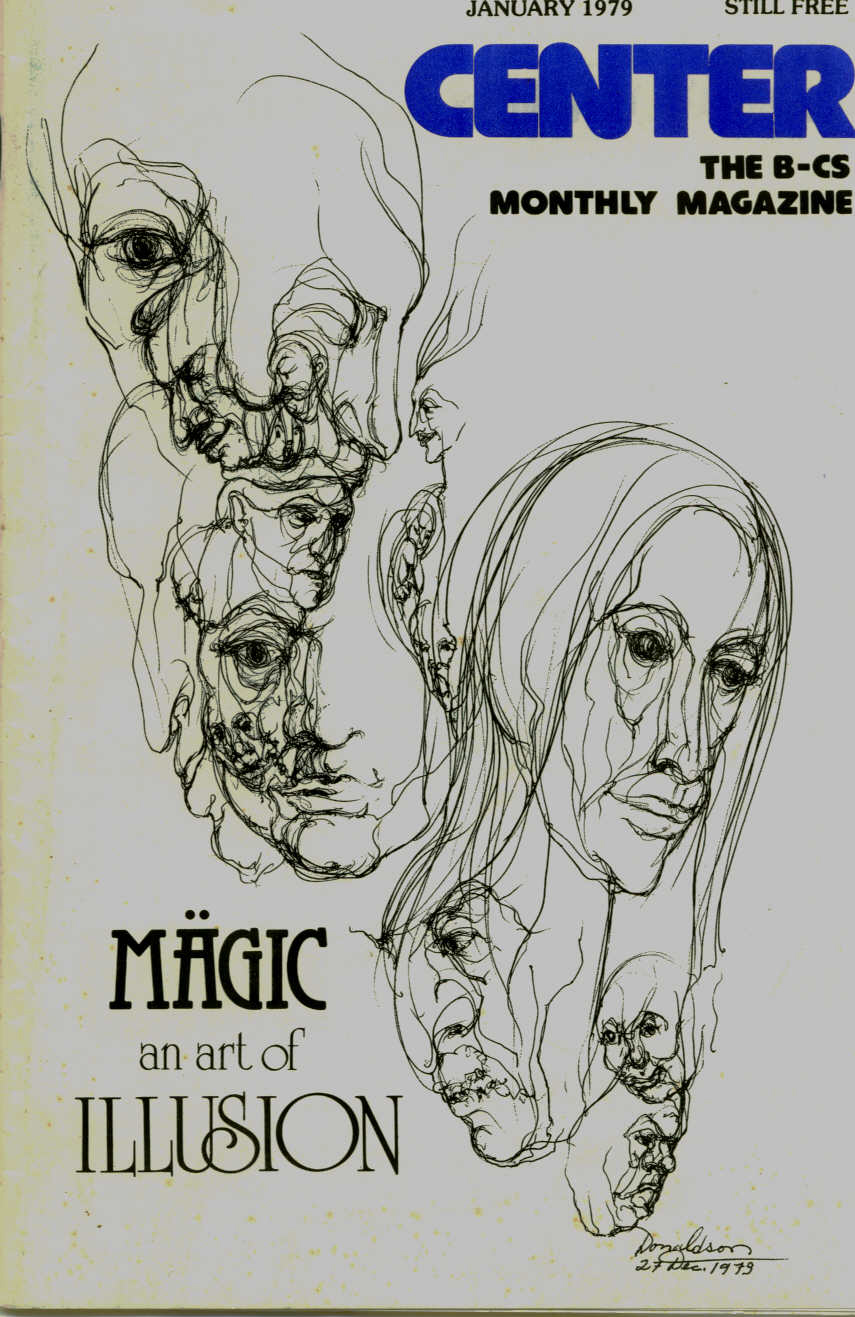 The cover of Center Magazine, January 1979 Joe loved to draw faces |
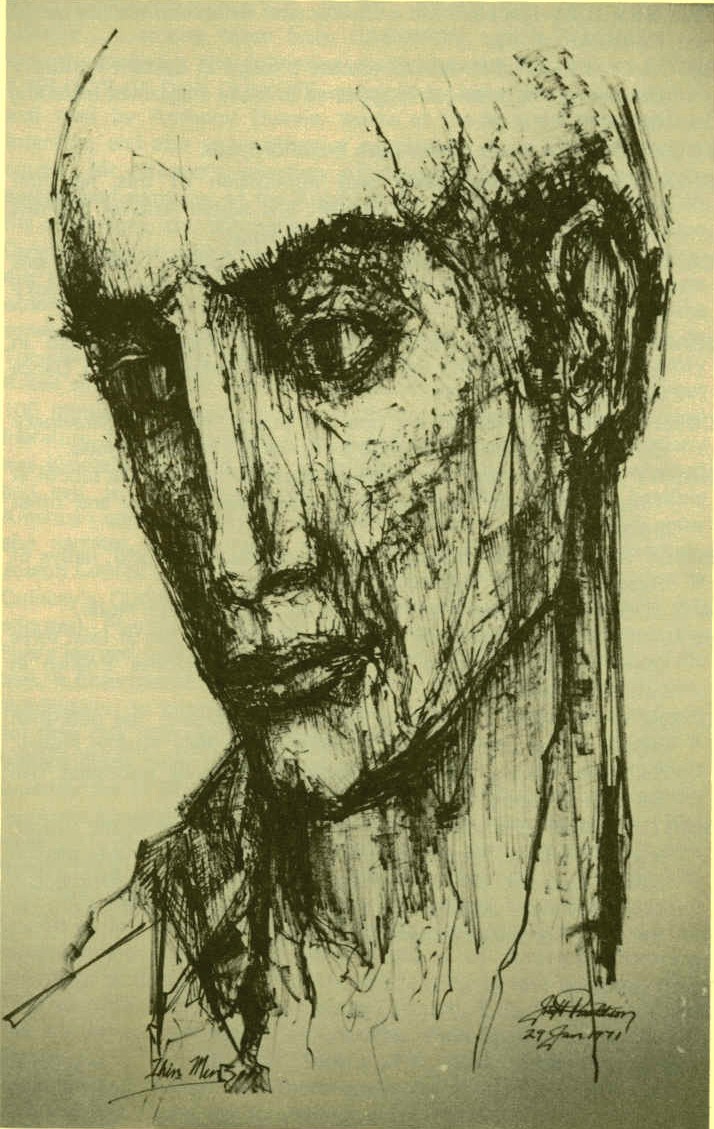 Thin Man, 1971 |
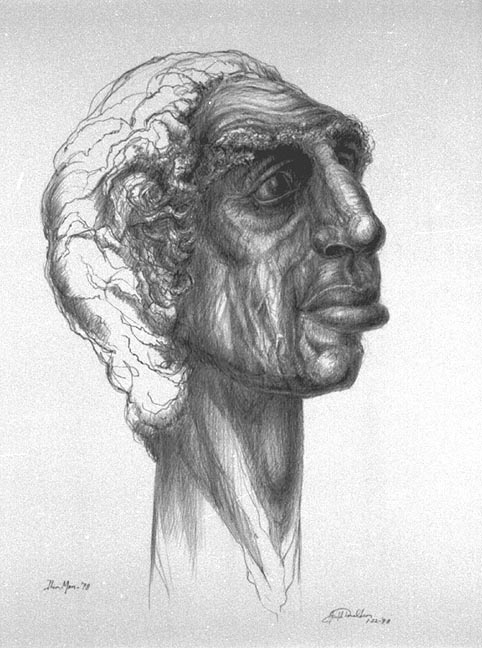
Thin Man, Jan. 22, 1978
dimensions unknown, watercolor and ink
(Photo by Tim Manning, image courtesy of James Baker)
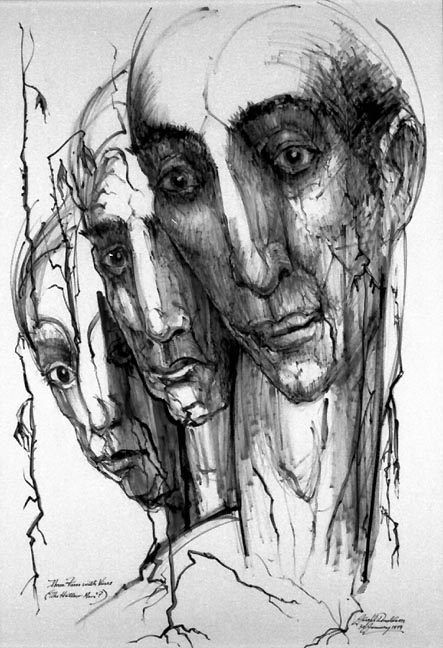
Three Faces with Venus (The Hollow Men?), January 30, 1979
dimensions unknown, watercolor and ink
(Photo by Tim Manning, image courtesy of James Baker)
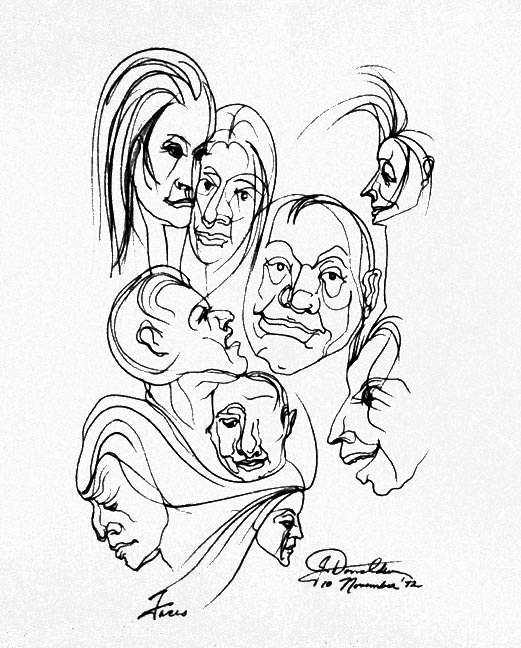
Faces, November 10, 1972
dimensions unknown, watercolor and ink
(Photo by Tim Manning, image courtesy of James Baker)
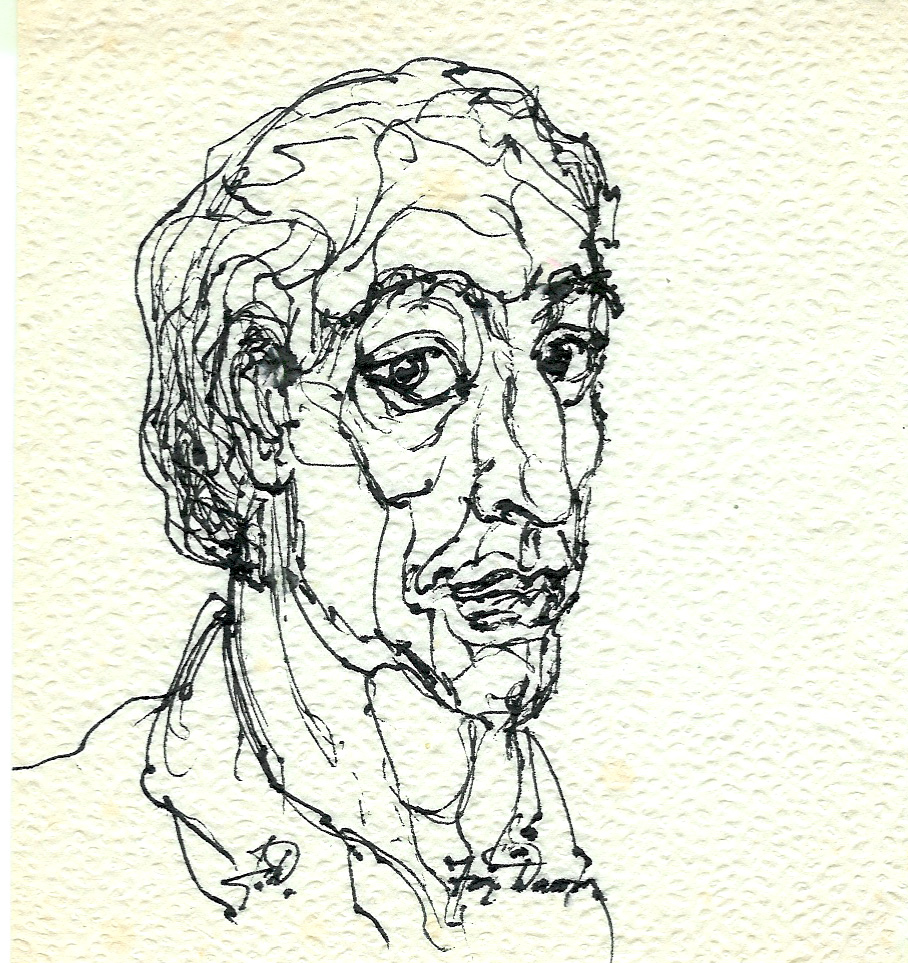
For Dawn (sketch), date unknown
This is one of Joe's many napkin sketches.
He drew it for Grace's great-granddaughter, Dawn, to whom he signed and presented it.
(Image courtesy of Summer Stone Callaway)
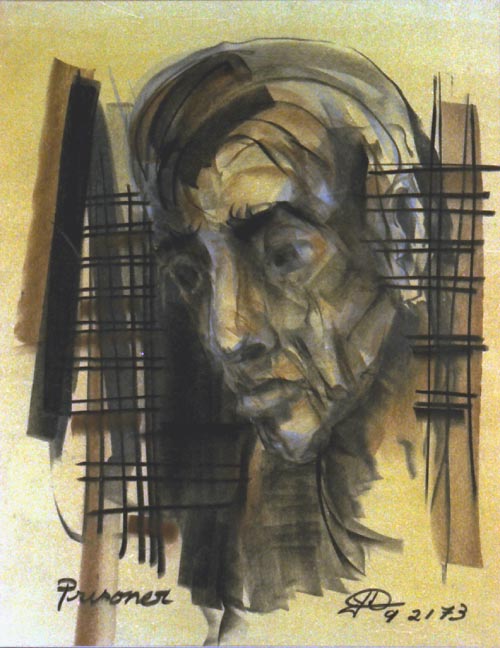
Prisoner, September 21, 1973
dimensions unknown, watercolor and ink
(Photo by Tim Manning, image courtesy of James Baker)
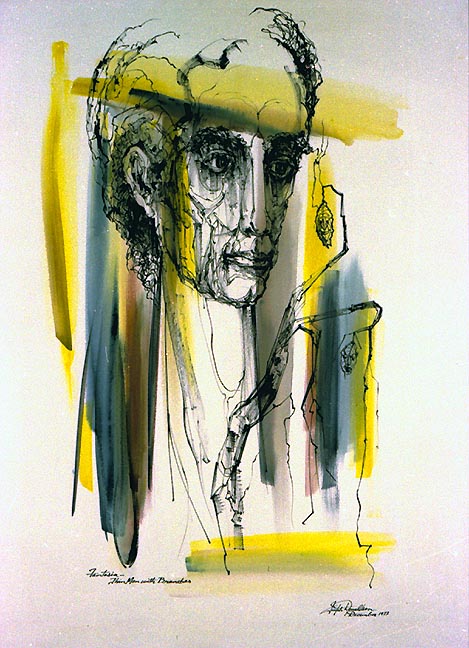 Fantasia - Thin Man with Branches, December 1973 dimensions unknown, watercolor and ink (Photo by Tim Manning, image courtesy of James Baker) |
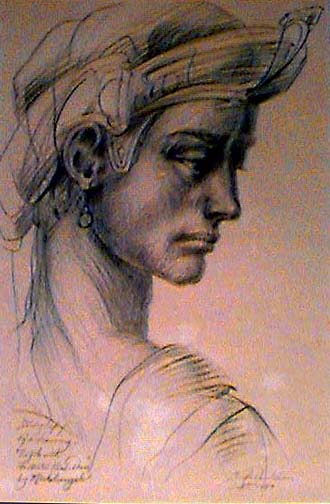 Copy from Michelangelo, 1984 18 inces by 12 inches, graphite on paper (Image courtesy of James Baker, original in the collection of Graham Horsley) |
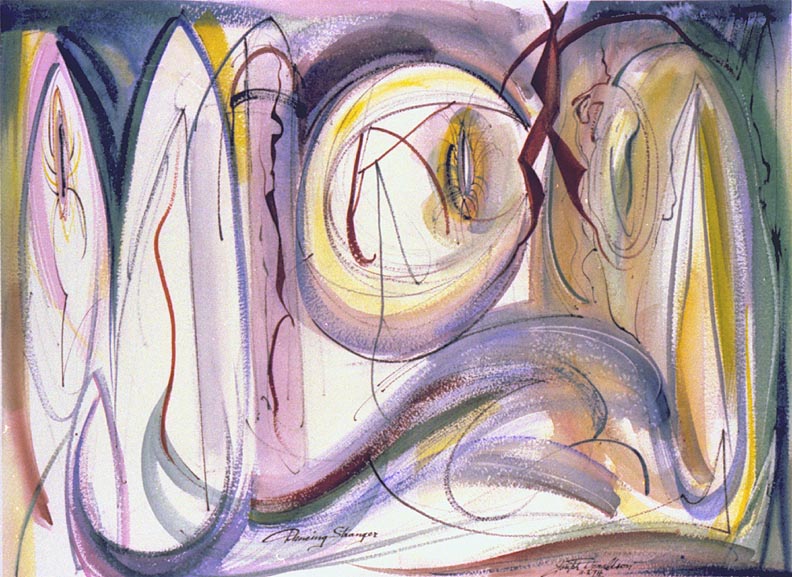
Joe loved to play with words. Not that he was the only person in the world who could recite Shakespeare's "Seven Portraits of Man Speech" (As You Like It, Act II, Scene vii), but Joe had that one memorized. He also told some funny stories about his earliest days in central Texas in the mid-1950s - having lived in New Orleans, Chicago, New York and the Virgin Islands, the local culture and ways of speech baffled him. As can be seen from the above scans of "Quartet" Magazine, Joe was also quite a poet. Below is a sample of his poetry, some written in his own hand.
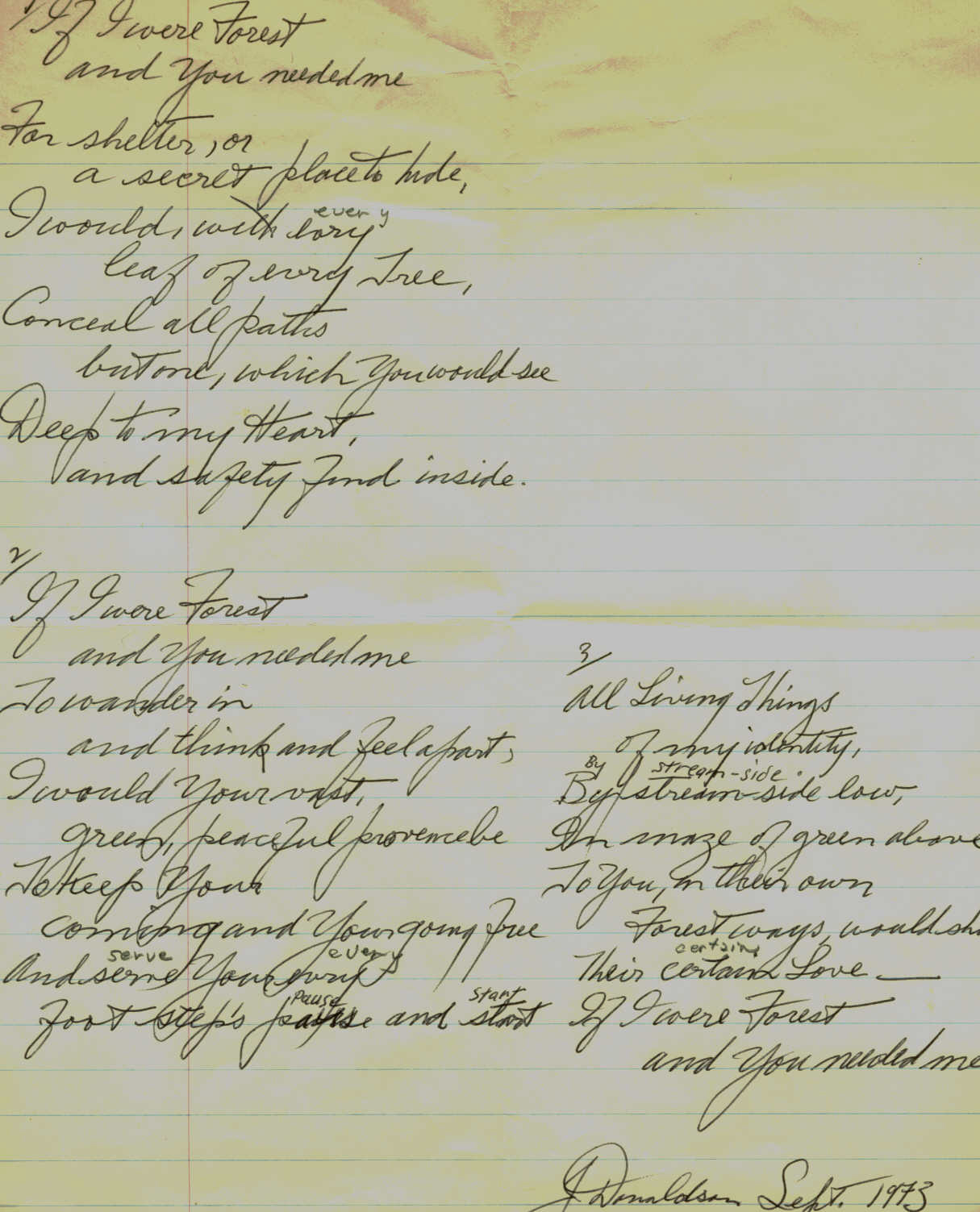
(Image courtesy of Katherine Wood)
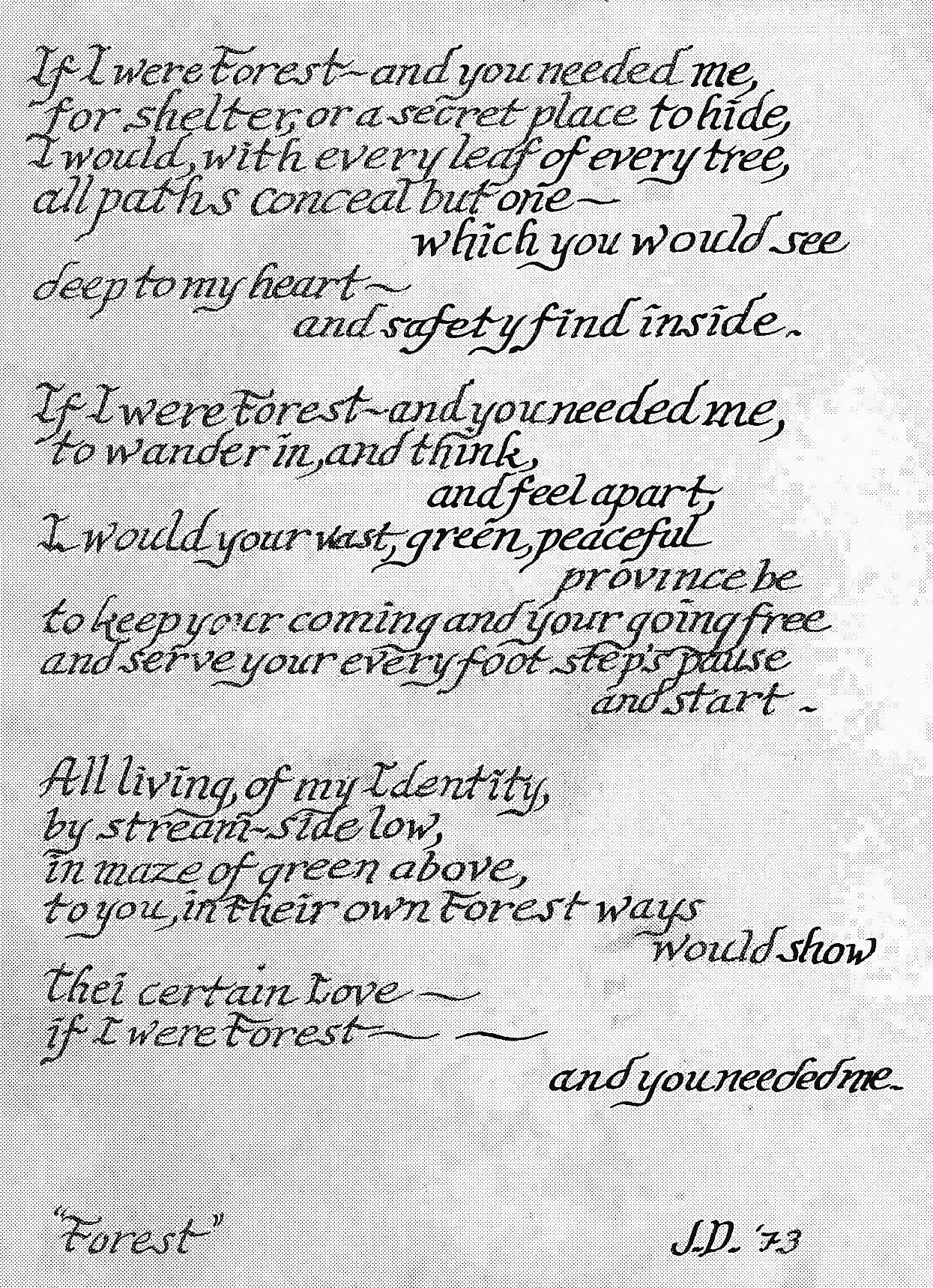
(courtesy of Dara Childs, Jr.)
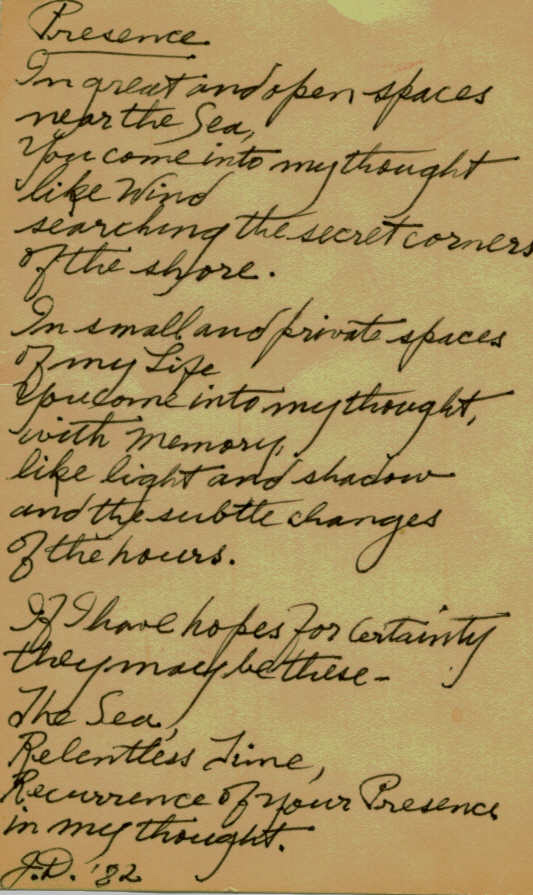
"Presence," by Joseph Donaldson, Jr., 1982
(Image courtesy of Katherine Wood)
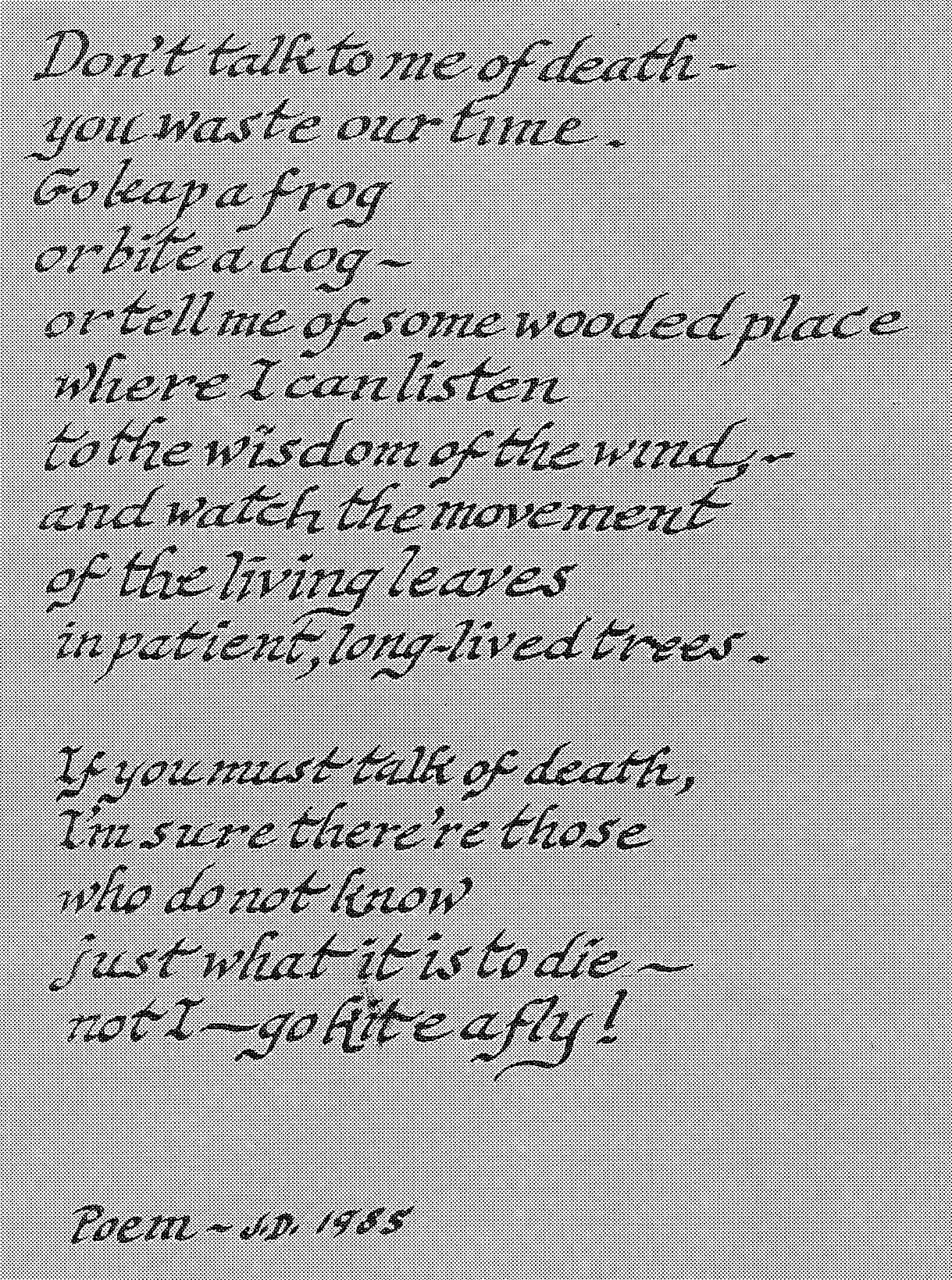
(courtesy of Dara Childs, Jr.)
The Room
He walked into the Silence of the Sighted
dark
Into the hearing Silence
of the darker room
His fingers found the
latch and closed the door
The unknown door within
the unseen place
Some place, somewhere, he
felt he'd never been
Some unfamiliar place he'd
never left.
His hands moved cautiously
along the wall
His footsteps followed,
naked on the floor,
They found the meeting of
a corner's walls
He crouched and closed his
arms around his knees.
The hours, or minutes,
fell like dust on stone,
Like finely sifted sand of
all Eternity.
Slowly his hand moved out
and, opened, cupped
To catch, perhaps, a
little silt of Time
It closed and held,
instead, the Pulse of Now –
The pulse of Now that was
the Now of Then
He held it close
And suddenly he knew –
Its beat had cleared a
passage in his thought.
All was not muted, blinded
stillness there
The Eyes that watched him
in the Dark were his
He heard the Silence and
the Silence spoke:
"You are no stranger here,
You have returned
Stand up and walk along
the wall –
The second wall your
fingers found before
Then follow to the next
And stand and hear
The Sound beyond the
shutters – stand and hear
Stand feet apart and feel
the movement too."
He rose, and following the
walls,
He stopped and heard –
It was the sound of
Sea –
Her sound, Her movement
seeming very near.
The sound grew strong – he
could not understand
Not having heard, or felt,
or understood before.
One hand still holding,
close, the Pulse –
The other reached and
found another latch
He pushed the shutters
open and the Sea was there
The solemn Vastness bright
in the moonlight then –
Bright, Timeless Vastness
in his Memory –
With all the ancient
Freshness felt again.
The Movement heightened,
entering the room.
His hand fell open and
released the Pulse
He freed the Pulse of Now,
the Pulse of Then
And knew, at last, a
final, stronger, unrelenting One.
He took the water's life –
as it took his.
Joseph
Donaldson
June 1974-July 1976
(courtesy
of Dara Childs, Jr.)
The Hunter (A Narrative in
Rhyme)
He was, for some unmeasured
sleep of time,
A stranger in an unknown,
friendless place,
A prayer unprayed, a saying
never said.
He suffered guilt for
uncommitted crime
His mirror showed a presence
not a Face.
He was a runner in an
unmarked race
A song unsung, a poem never
read.
His travels took him far, but
never There
A troubled searcher, he, who
searched in vain
He was the missing fragment
of a broken thought
His mission was to reattach,
repair
And so to see his mirrored face again,
To know detachment,
namelessness and pain
If doing so would find the
Self he sought.
And Time, asleep, must of
itself awake
But for this hunter with
an unfound prey,
Time waking quietly was no
sudden thing.
At last he was a knowing
prayer to make,
A poem and a song, to read,
to sing, to say –
A runner eager to explore the
way
A certain Face who knew its
mirroring.
One day he walked in calmness
on the shore.
He walked with strength
of reclaimed Self, alone,
Then rested near the rocks
and touched the Sea.
He knew the sights and sounds
he'd known before –
The cry of the gull, the
dance of surf spray blown,
He knew the Sky and Water's
vastness as his own
And asked a question – old as
Time may be,
"Have I found Self or Selves
in finding me?"
Joseph
Donaldson
October, 1976
(courtesy
of Dara Childs, Jr.)
but it is one that he enjoyed recounting:
I once knew a woman from Britain,
Who said she would knit me a mitten.
When I asked why not two,
She exclaimed "greedy you,
Be glad with the mitten you're gitten!"
(courtesy of Dara Childs, Jr.)
Although Joe's second wife, Grace, died in 1965, he remained close to her grandchildren (especially Gayle's daughters) throughout his life. One of them was particularly influenced by Joe's interest in literature.
"I was in fifth grade in New Orleans and studying poetry. Gayle and I took our first plane trip to Texas to visit Joe for a week. When asked, I told him my favorite poet was T.S. Elliot and he gracefully agreed to recite from memory The Lovesong of J. Alfred Prufrock, although he did so with his back turned to me so as not to stutter too badly. That same week he recited numerous limericks, several of his own and he encouraged me to write my own poems. Unbeknowing to me or my mother, he mailed one of my poems to a children's magazine to be published and sent me a copy for my birthday. It was one of the proudest moments of my childhood. I went on to major in literature with a special love for T.S. Elliot."
- Shannon Stone Rhodes
After retiring from Texas A&M University, Joe was granted the title of professor emeritus, and lived in his house on N. Ridgefield Circle. I went there to visit him fairly often beginning in the late 1980s.
One day (in 1987) Joe
was trying to teach me how
to draw the human face. He grabbed a book from a shelf, and referring to some examples in it, he made these quick skull sketches on a sheet of paper. He then glued the paper to a piece of cardboard and gave it to me. |
For my eighteenth birthday Joe gave me this book. He had very fine script. |

"I remember taking his car out to put gas in it, and he always wanted a blend of unleaded and premium unleaded...and then they came out with the blend of fuel in between, and I put that in the car...and man did he flip out when I told him what I had done. He was so picky, and such a creature of habit. The car was fun though...all kinds of luxury gadgets. What a powerful engine."
- Dara Childs, Jr.
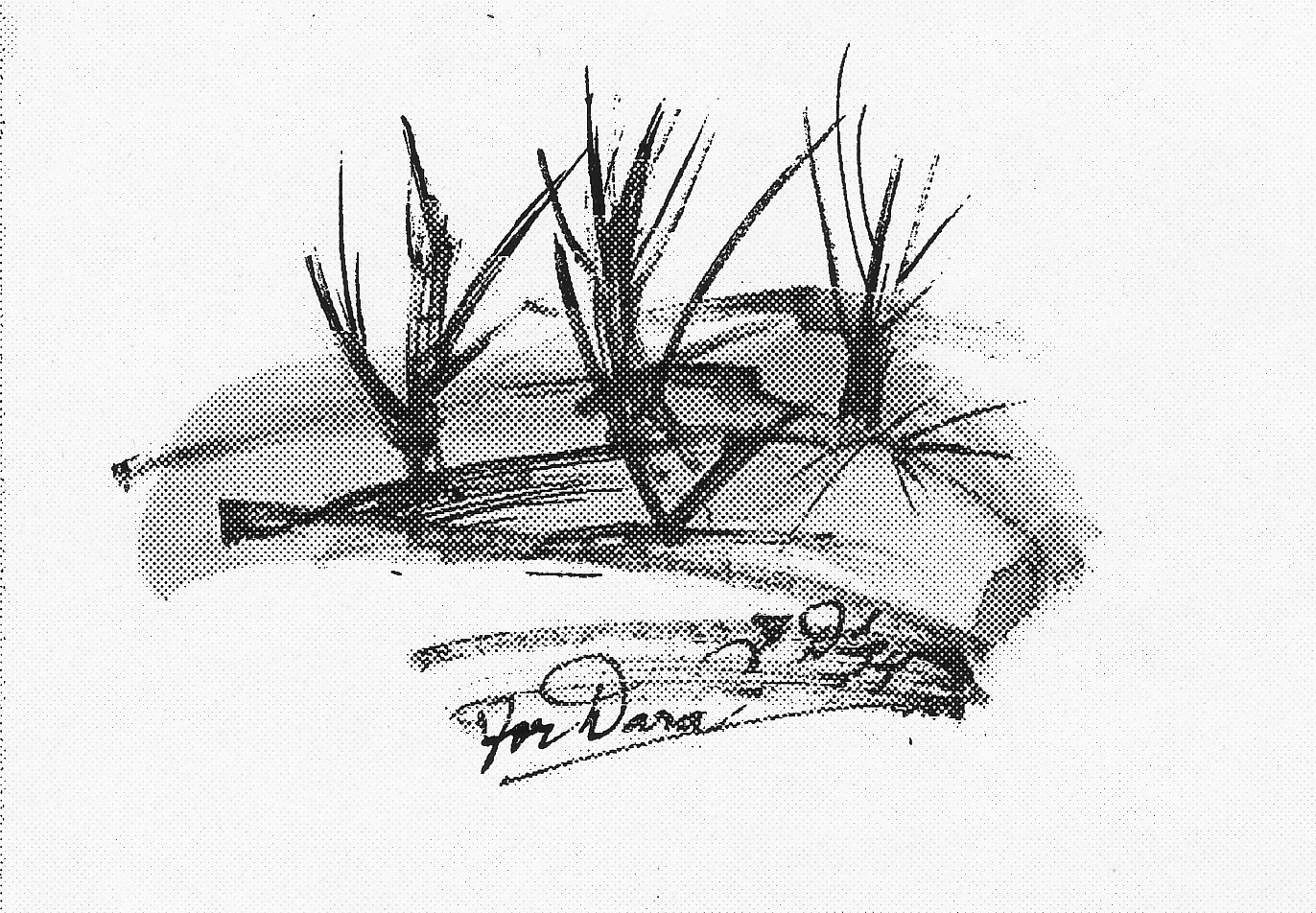 "For Dara" - the front
cover of a greeting card Joe sent to Dara Childs
(courtesy of Dara Childs, Jr.) |
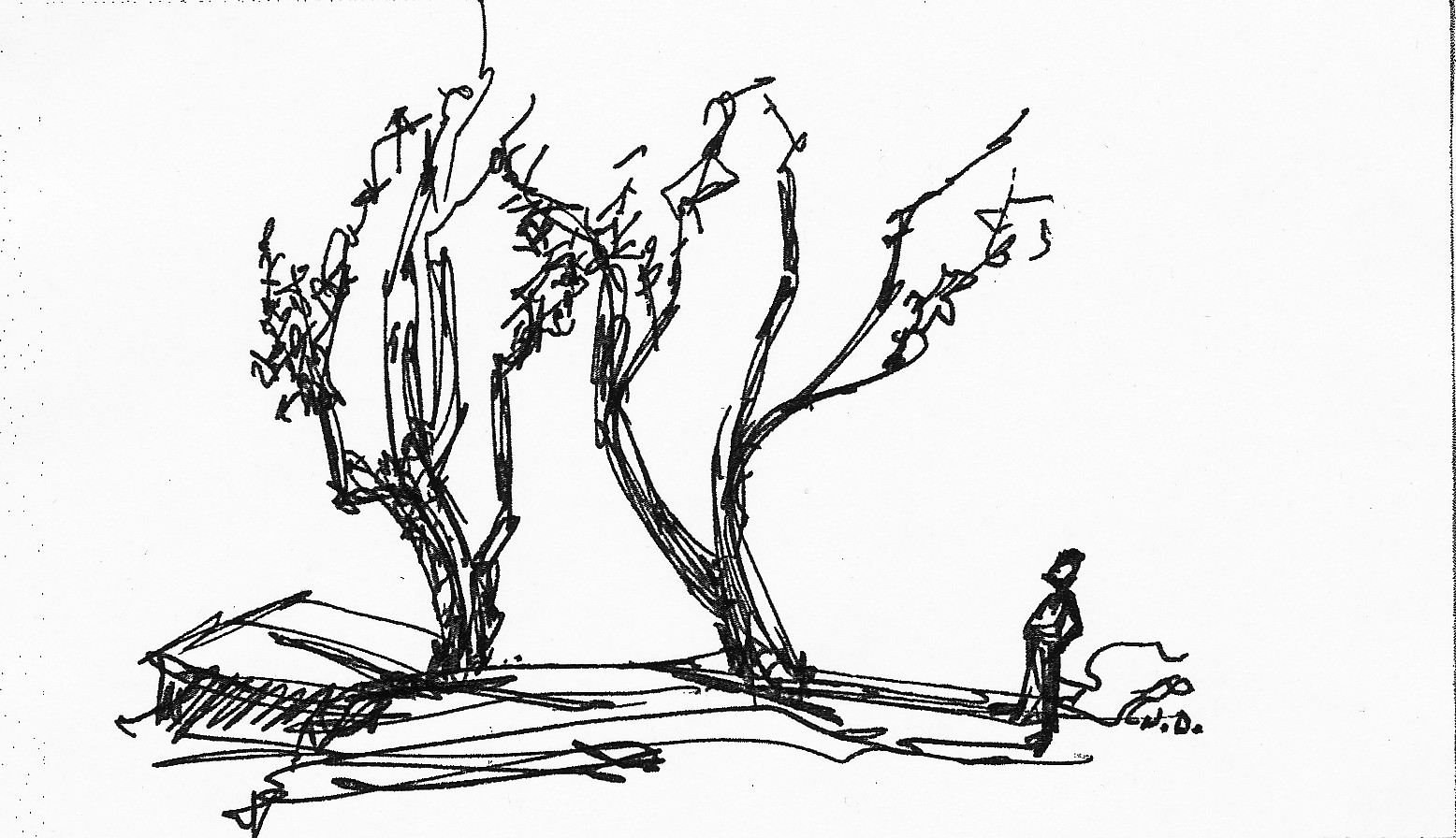 "Little Man" - a sketch
Joe gave to Dara Childs
(courtesy of Dara
Childs, Jr.)
|

(courtesy of Dara Childs, Jr.)
To commemorate his eightieth birthday, Joe made up the following limerick:
A fact, that to some may be known,
I'm eighty and living alone.
An eccentric old farter,
No wife, son, or daughter,
And the pain in my ass is my own!
Joe had his own way of living. He refused to attend funerals - he did not even go to his parents' funerals or to those of his sister or her husband. Some may have though badly of him for his refusal to budge on this matter, but in the end he did put his money where his mouth was, so to speak; not only did he once tell me that he wanted no funeral to be held for him, he made legal arrangements to this effect in his will. Exactly why I do not know, but Joe was steadfastly anti-funeral. Joe also tended to reject what did not sound good to him. For example, he had a habit of drinking tea in the evenings (he was still a night owl when I knew him) but drinking tea caused him to get up many times during the night for trips to the bathroom, which left him feeling drowsy and unrested much of the day. Those near to him (including my mother) suggested that he lay off the tea, but that idea did not suit him. It was a constant problem in his later years. There was a time when he asked me to take a look at a plastic camera he had bought. He wanted to use it, but the winding mechanism was not working properly. It was not the kind of camera that one could have repaired, so I suggested that he buy a stronger, fully-automatic camera. Since he could not accept my diagnosis, I took the camera to the university photo lab where I served as a student worker. There, my co-worker (a professional photographer) confirmed my opinion. I returned the faulty camera to Joe and told him of the final diagnosis. It took a little time but eventually, amid diminishing protestations, he gave up on the camera and let go of the matter. I was not bothered, of course - it was just his way.
Some who knew Joe wanted to get him out of his house from time to time (other than just for doctor visits), but he rarely left after about 1990. My mother succeeded in getting him to come over for dinner on a number of occasions, and he would always dress well. I remember that he did not get along with the family dog - a lovable if not slightly nervous terrier mutt named Jackie. Once or twice, after I had moved out of the house, Joe wrote to me about how he had enjoyed supper at my mother's place the previous night, and joke about how "well" he and Jackie had gotten along. Probably sometime in 1994 I invited the old man to attend a performance of Don Quixote on the Texas A&M University campus - I had an extra ticket for the front row - but he declined. While he could manage visits to the house, I guess it had become too difficult for him to go out in public anymore. It probably made him too tired, seeing as that he could not sleep well at night.
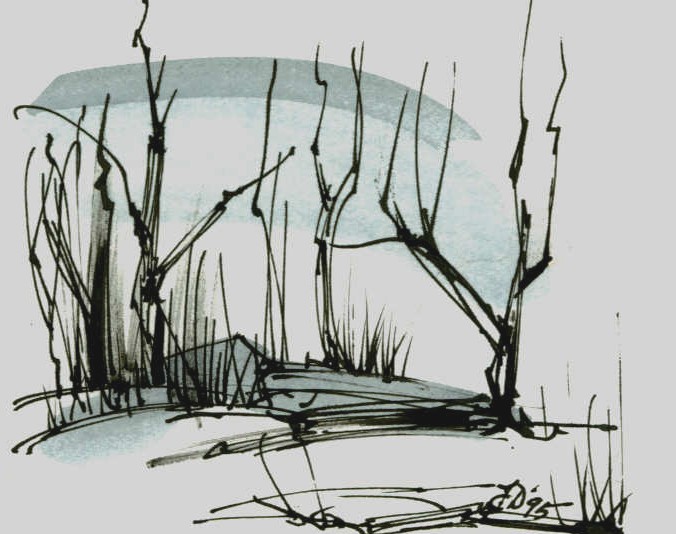
Joe gave this to my mother.
(Image courtesy of Katherine Wood)
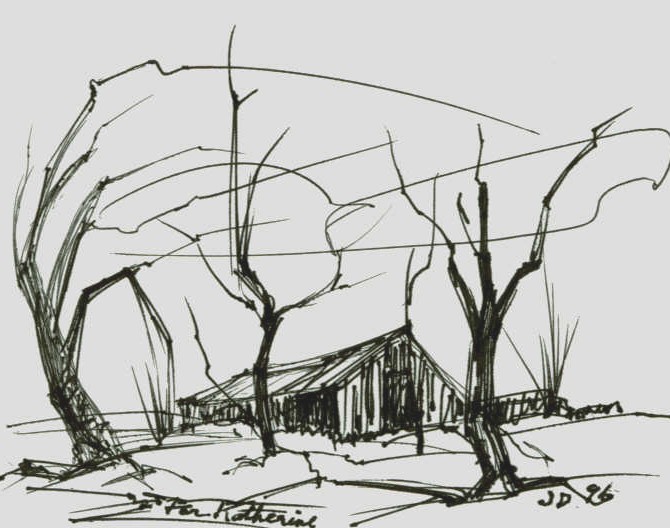
another sketch Joe gave to my mother
(Image courtesy of Katherine Wood)
The last time I saw Joe was July twentieth, 1995, shortly before leaving for an extended stay in Japan. Over the course of the next year and a half we exchanged letters (sometimes about his encounters with Jackie) and talked on the telephone from time to time. I do remember that I called him on November tenth or eleventh, 1996, to inform him of the birth of my daughter, and that he seemed very pleased to hear the news. Although I was to return to Texas the following year, Joe did not have enough time left; his health rapidly deteriorated, and late the next month he was admitted to St. Joseph's Hospital in the neighboring city of Bryan. There, in the early morning hours of January first, he died at the age of eighty-two. I had so wanted to take my daughter to his house and talk to him and gaze once more at all of his work, but by the time I made it back to that town, he was gone. His objection to the holding of a funeral for him was honored, so once he was gone he really was gone. But at least Joe can be remembered, for he had some relatives, many friends, and had also taught numerous people in his life, some of whom are now professional artists. Today there is a scholarship in his name at TAMU, "awarded to encourage a sophomore environmental design student who shows professional promise and an interest in the environment, community service and university extracurricular activities" (http://archweb.tamu.edu/college/admissions/scholarships/arch.html).
One of Grace's granddaughters recalls her last time to converse with Joe:
"The night before he was to go into the hospital (for knee surgery I think) he called to let me know that he had written an account of his life with Grace as I had asked him to do. He was quite nervous about this hospital trip because I think he knew that he wasn't coming home. I poo-pooed his nervousness, as he was quite prone to getting worked up about sickness. I was never to hear from him again. Ah, hindsight...and 'if only's'... I wish now that I had allowed Joe to say good-bye, for that is really why he called."
- Sarah McDermott Stone Griffiths
There are more than a few people who miss Joe very much.
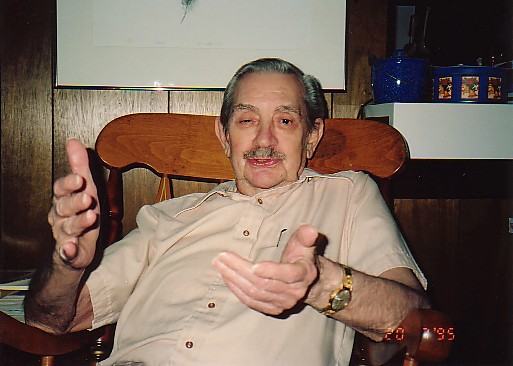
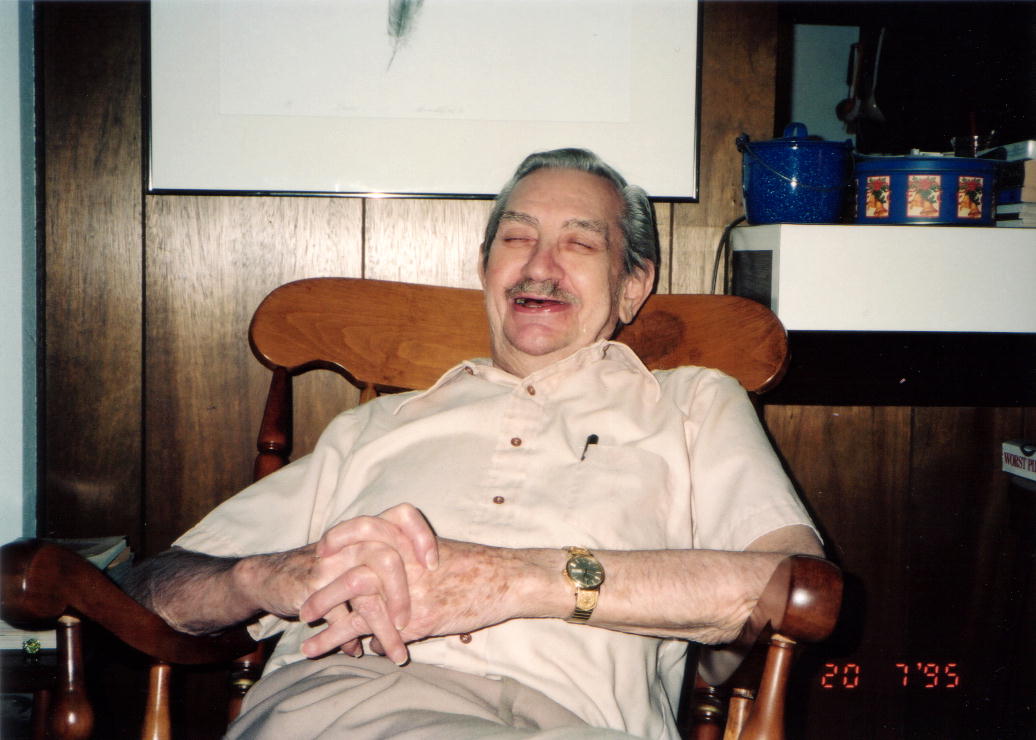
(Photos by D.C. Wood)
For more on Joe's lifetime, his artwork, and New Orleans:
- "Only Yesterday: An Informal History of the 1920's," by Frederick Lewis Allen, 1931 (1957, New York: Harper & Brothers)
(a very readable overview of the decade in which Joe came of age)
- "A Nation In Torment: The Great American Depression, 1929-1939," by Edward Robb Ellis, 1970, New York:Coward-McCann
(a fascinating, thorough, and human discussion of the decade during which Joe studied in Chicago,
and worked with the Federal Art Project - Chapter 27 details the Works Progress Administration)
- "New Orleans Stories: Great Writers on the City," by John Miller, ed., 1992, San Francisco: Chronicle Books
(a wonderful collection of short pieces by various authors on New Orleans - "Growing Up in New Orleans"
by Louis Armstrong is a must-read)
- "Panic in the Streets," directed by Elia Kazan, 1950
(This film is recommended by Fred Hatfield, long-time resident of New Orleans, jazz affectionado,
and chronicler of historic cemeteries.)
- "Dinner at Antoine's," by Frances Parkinson Keyes, 1949 (orig. 1948), London: Eyre & Spottiswoode.
(This harcover edition contains 23 of Joe's original illustrations, plus the endpaper design - a drawing he did on
Rue Saint Louis in the French Quarter, depicting the facade of the landmark restaurant.)
- "The Art Spirit," by Robert Henri, 1960, New York: J.B. Lippincott.
(Joe definitely had the "art spirit" - he lived it.)
A number of people have helped build this museum by providing images and/or information. Much thanks to:
Katherine Wood, James Baker, Joseph Donaldson Buck, Sr., Shannon Stone Rhodes,
Sarah McDermott Stone Griffiths, Summer Stone Callaway, Dara Childs, Jr., Sheldon Minkon, Dan Malcolm,
John Clemmer, Fred Hatfield, Todd Maxwell, Ken Zindler, Bruce R. Riggs, Roger Jackson, Buzz Jackson, Jacquie Ferrency, William Boggess,
Francine Stock, Martin and Joany Lanneau and Dennis and Todd Headington.
I am also grateful to Dr. Tim Manning, Texas A&M University, for photographing many of Joe's works back when
the old man was still living - something I regret not having the foresight to do myself.
Last updated on August 20, 2018
Questions and comments are welcome - wood (at) med.akita-u.ac.jp